In honor of Asian American, Native Hawaiian, and Pacific Islander Heritage Month, we recognize astronauts with Asian roots who have flown to the International Space Station and contributed to its assembly, operations and research activities. They were preceded in space by other pioneers. The first person in space of Asian origin was Phạm Tuân of Vietnam who spent eight days aboard the Salyut-6 space station in 1980 as part of the Soviet Union’s Interkosmos program to fly cosmonauts from friendly socialist countries. The first American in space of Asian heritage, Ellison S. Onizuka, flew as a mission specialist aboard space shuttle Discovery’s STS-51C mission in 1985. He tragically lost his life in the January 1986 space shuttle Challenger accident.
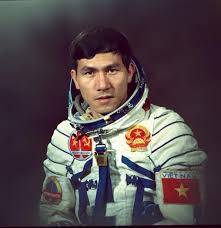
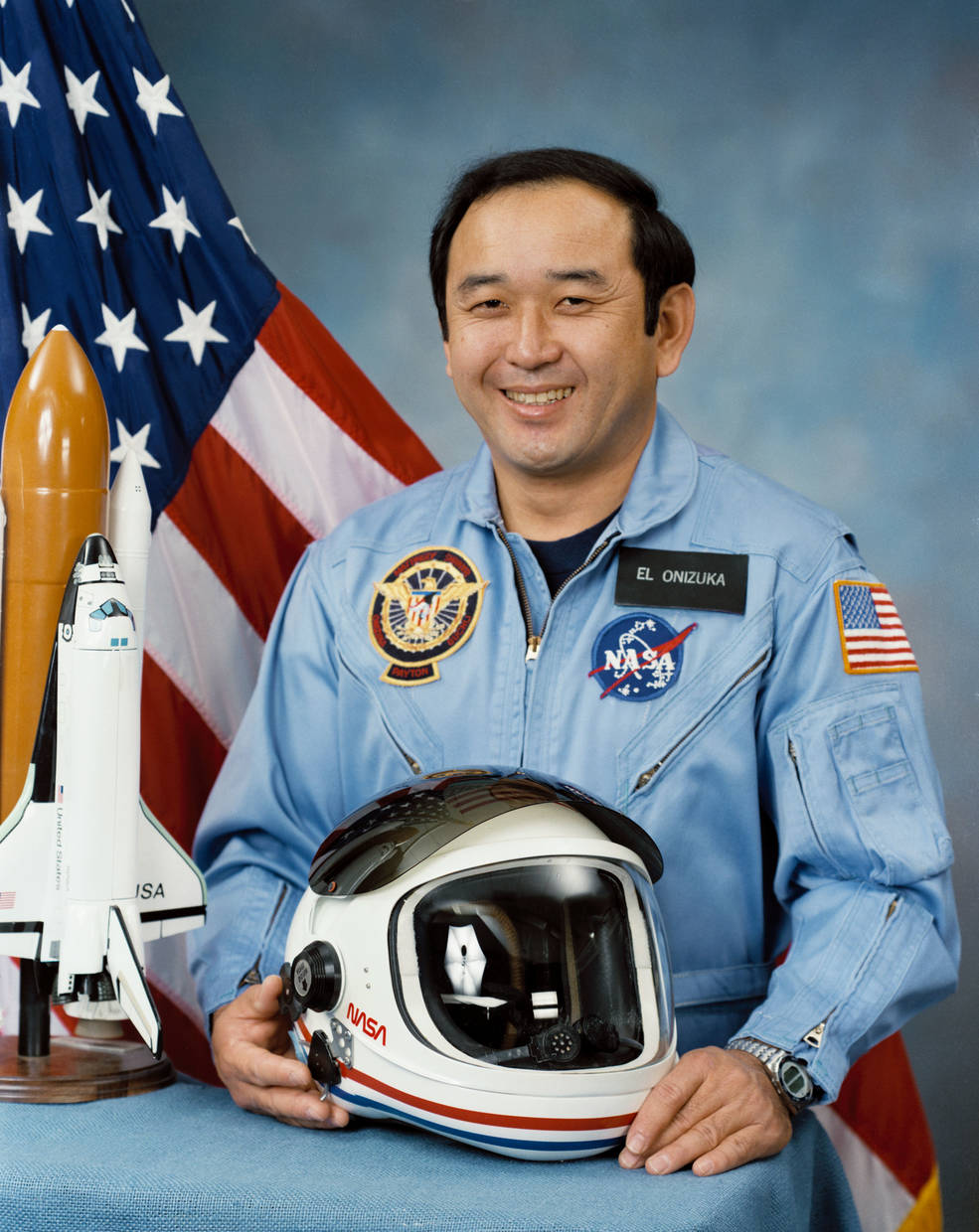
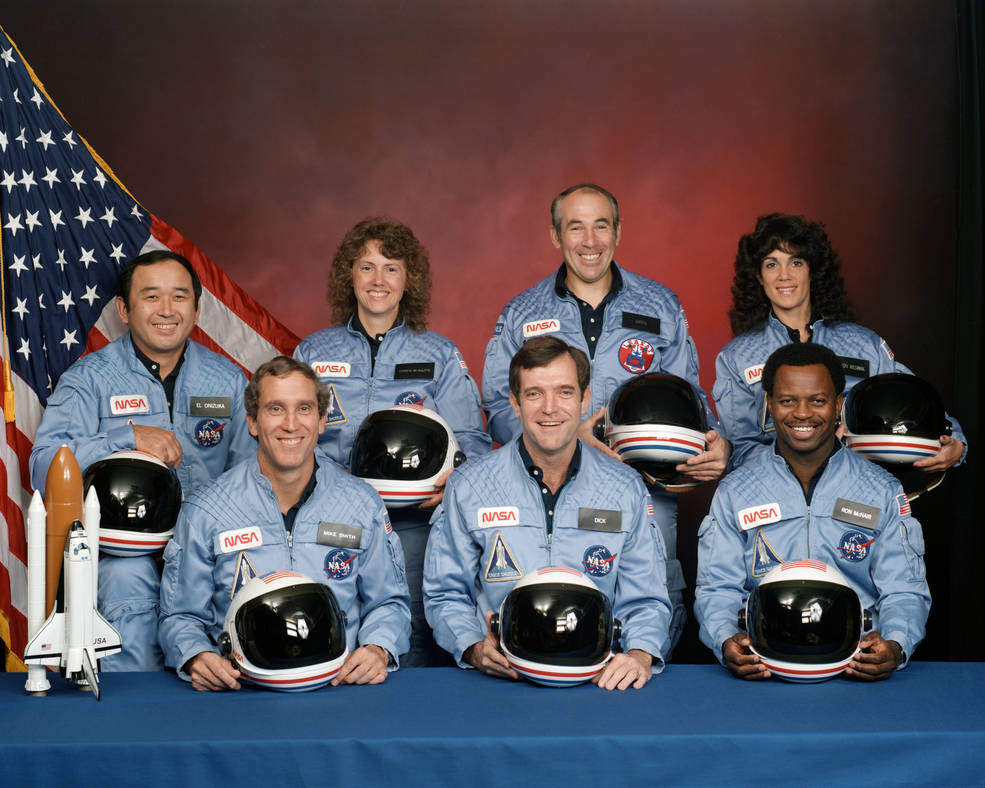
Left: Vietnamese cosmonaut Phạm Tuân. Middle: Official NASA portrait of astronaut Ellison S. Onizuka. Right: Official crew photo of the STS-51L crew lost in the Challenger accident, with Onizuka in back row at left.
In this article, we recognize the American astronauts of Asian, Native Hawaiian, and Pacific Islander heritage, and astronauts from Asian nations who have flown aboard the space station, contributing to its construction and operation and conducting the world-class research for which the station is well known. The table below lists these individuals who have shared in this remarkable international adventure. Asian American astronauts from recent selections await their chance to contribute to the success of the space station and to future exploration missions.
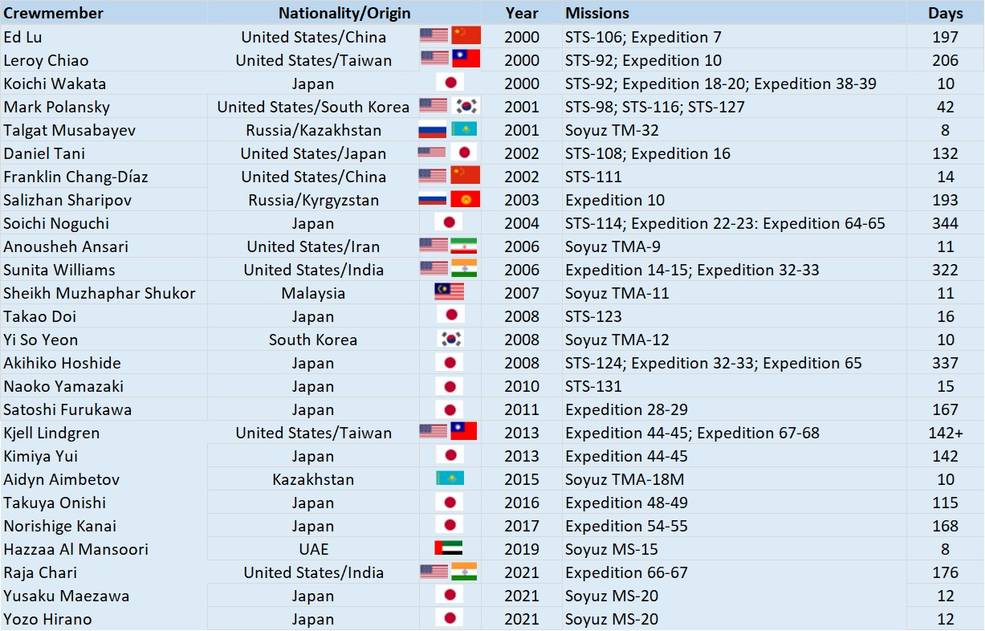
Table of Asian and Asian American astronauts and cosmonauts
who have visited the International Space Station.
The honor of being the first Asian American to fly to the space station belongs to NASA astronaut Edward T. “Ed” Lu. Already a veteran of STS-84, the sixth Shuttle docking mission to the Russian space station Mir, Lu served as a Mission Specialist on STS-106. He and his six crewmates launched on Sep. 8, 2000, with the primary goal of preparing the station for its first occupants. At the time, the station comprised just three modules – the Zarya Functional Cargo Block, the Unity Node 1 and the Zvezda Service Module. Zvezda, the latest addition to the station, had just arrived two months earlier. At the station, the crew’s duties included unloading a Progress resupply craft of its cargo and transferring logistics from the double Spacehab module in Atlantis’ payload bay. Lu and crewmate Russian cosmonaut Yuri I. Malenchenko conducted a six-hour spacewalk to connect electrical cables between the Zarya and Zvezda modules and to install a boom magnetometer on the outside of Zvezda.
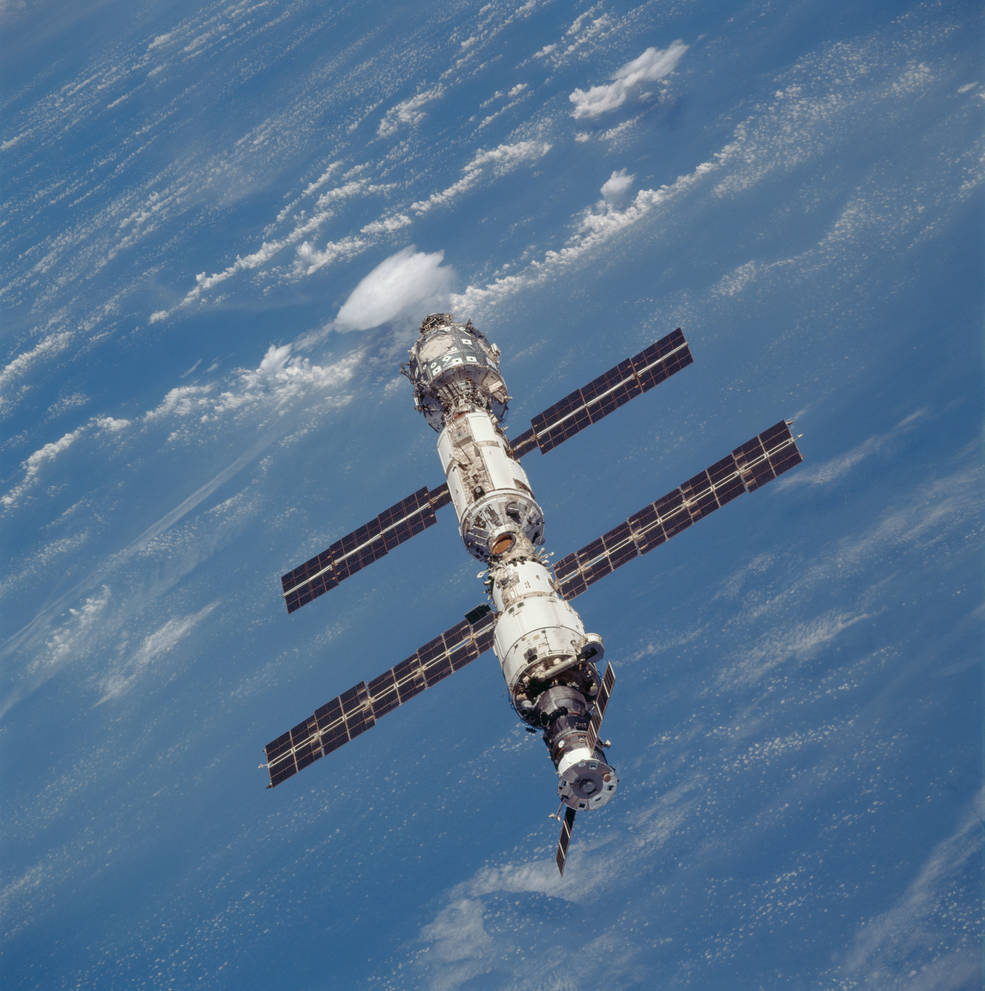
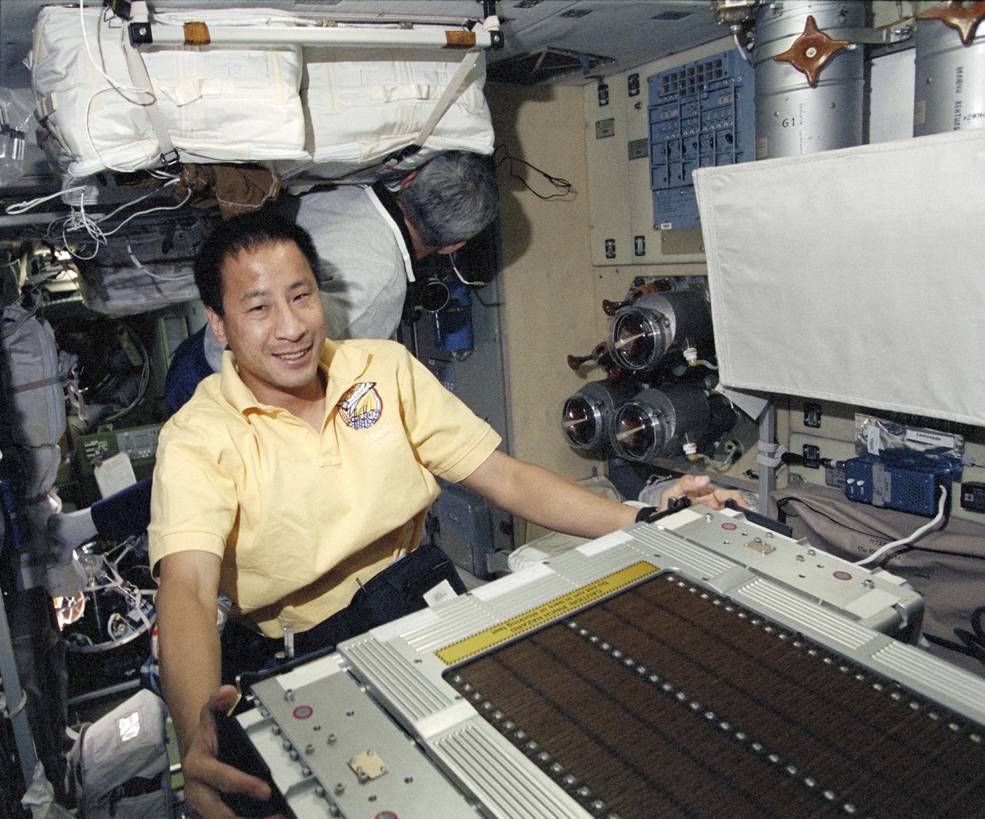
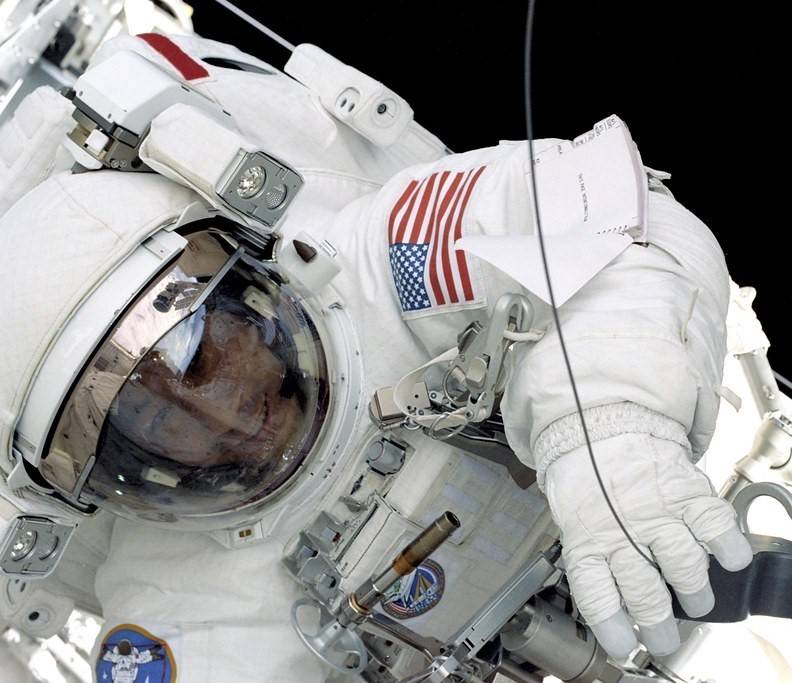
Left: The International Space Station as it appeared in September 2000. Middle: NASA astronaut Edward T. Lu installing the treadmill in the Zvezda module during the STS-106 space shuttle mission. Right: Lu during the STS-106 spacewalk.
Lu returned to the space station in 2003, this time as Expedition 7 flight engineer, with his STS-106 crewmate Malenchenko as his commander. They launched on April 26 aboard Soyuz TMA2, the first two-person long-duration crew following the Columbia accident. The station had grown significantly since their last visit, with the addition of the Destiny U.S. laboratory module, the Canadarm2 robotic manipulator, the Quest airlock, a pair of large solar arrays, and two truss segments. In tribute to his home state of Hawaii, Lu enjoyed wearing colorful Aloha shirts and used Hawaiian musical instruments called pu’ili sticks for an educational demonstration. Aware of his penchant for the colorful Hawaiian shirts, personnel in the Mission Control Center at NASA’s Johnson Space Center in Houston all wore them to remotely celebrate Lu’s 40th birthday in July. Lu and Malenchenko returned to Earth in October 2003 after spending 185 days in space.
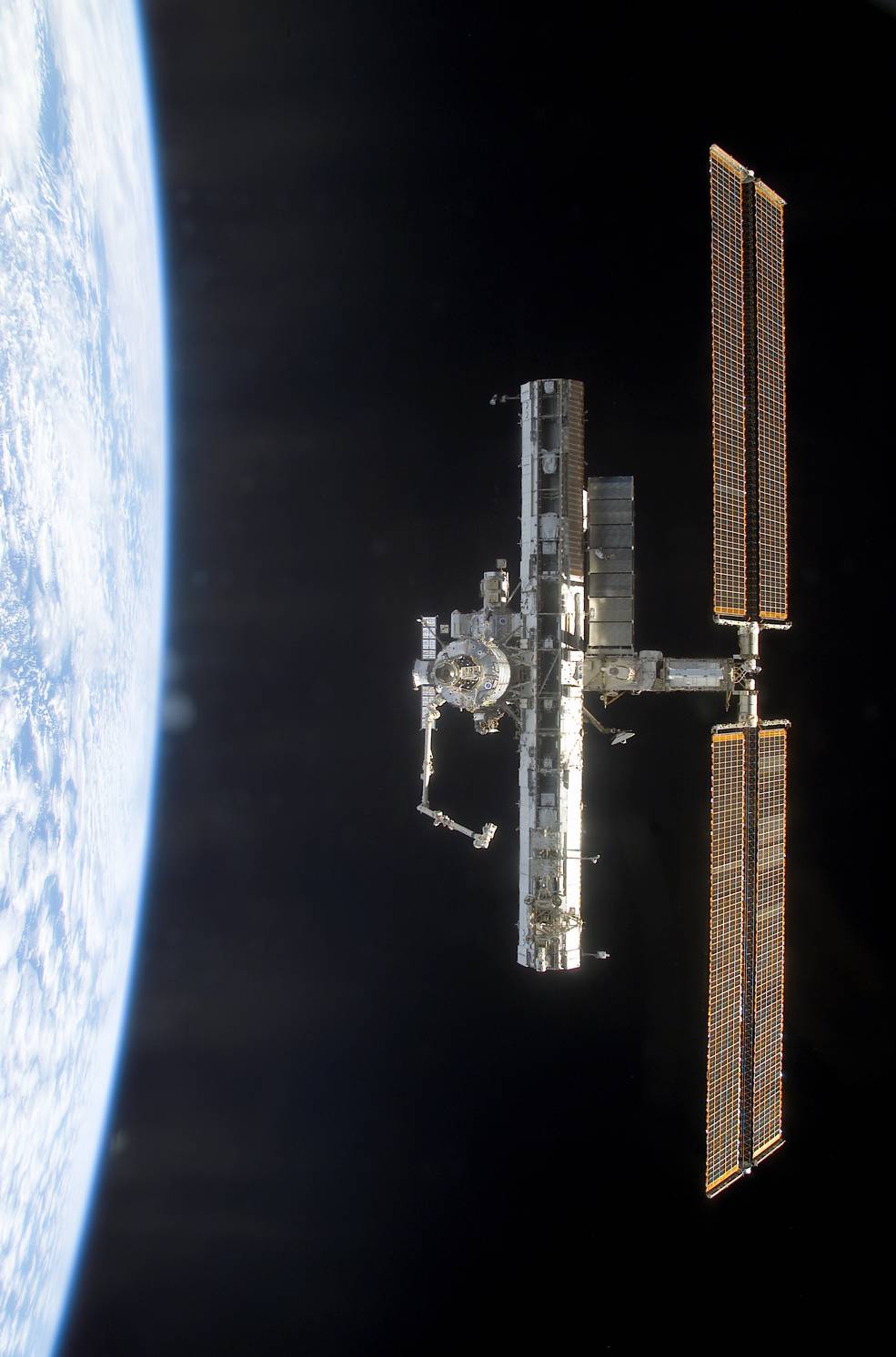
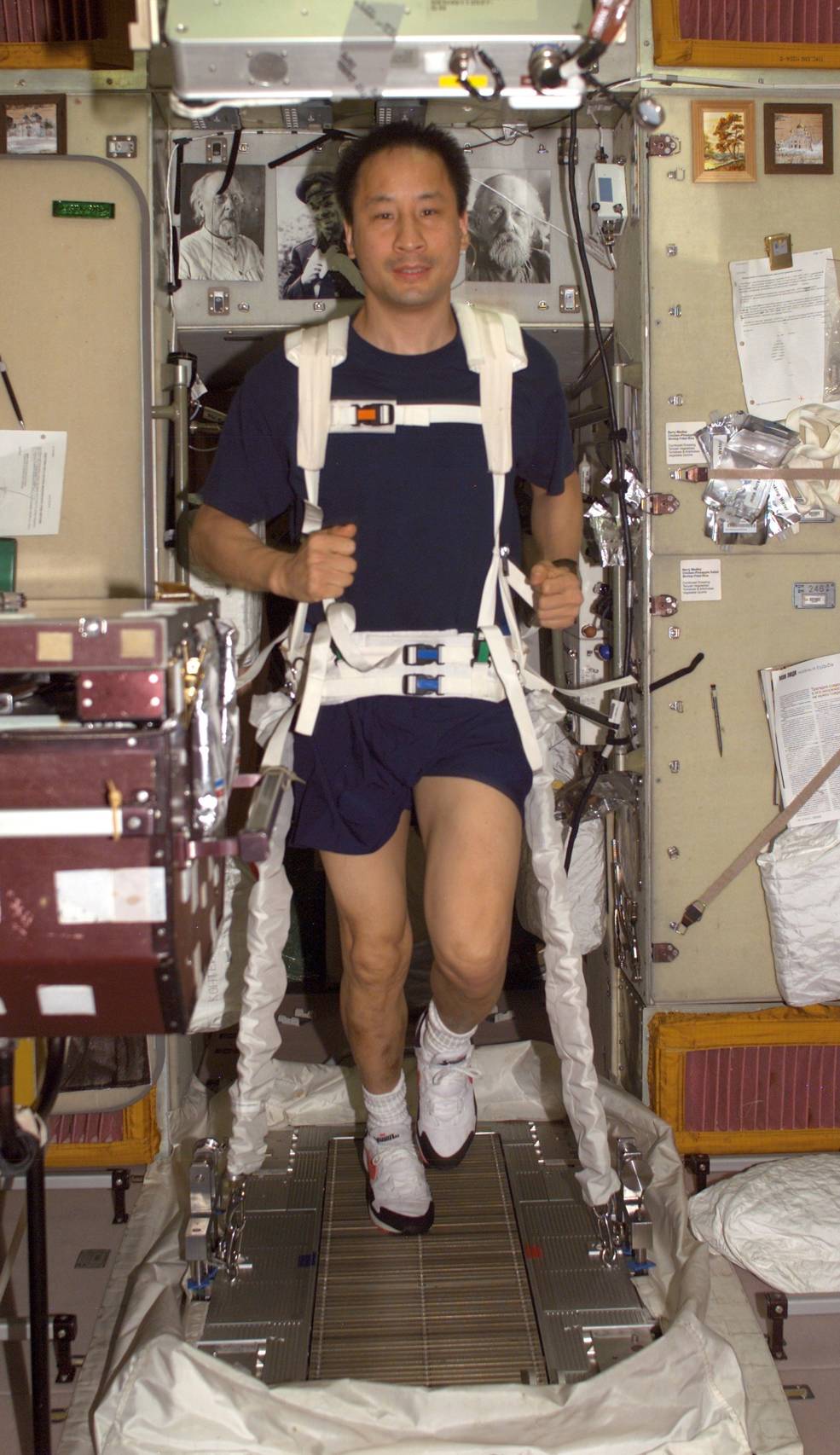
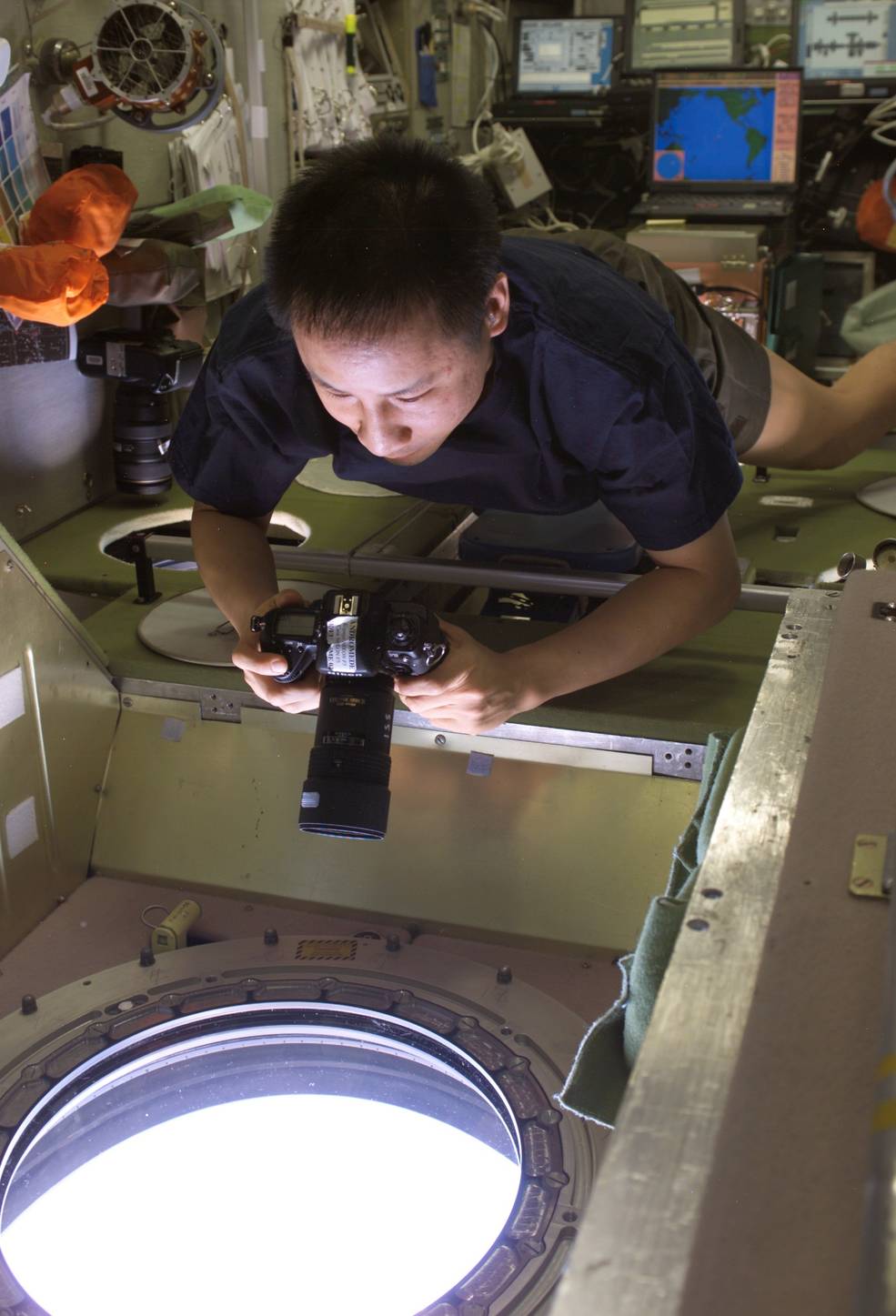
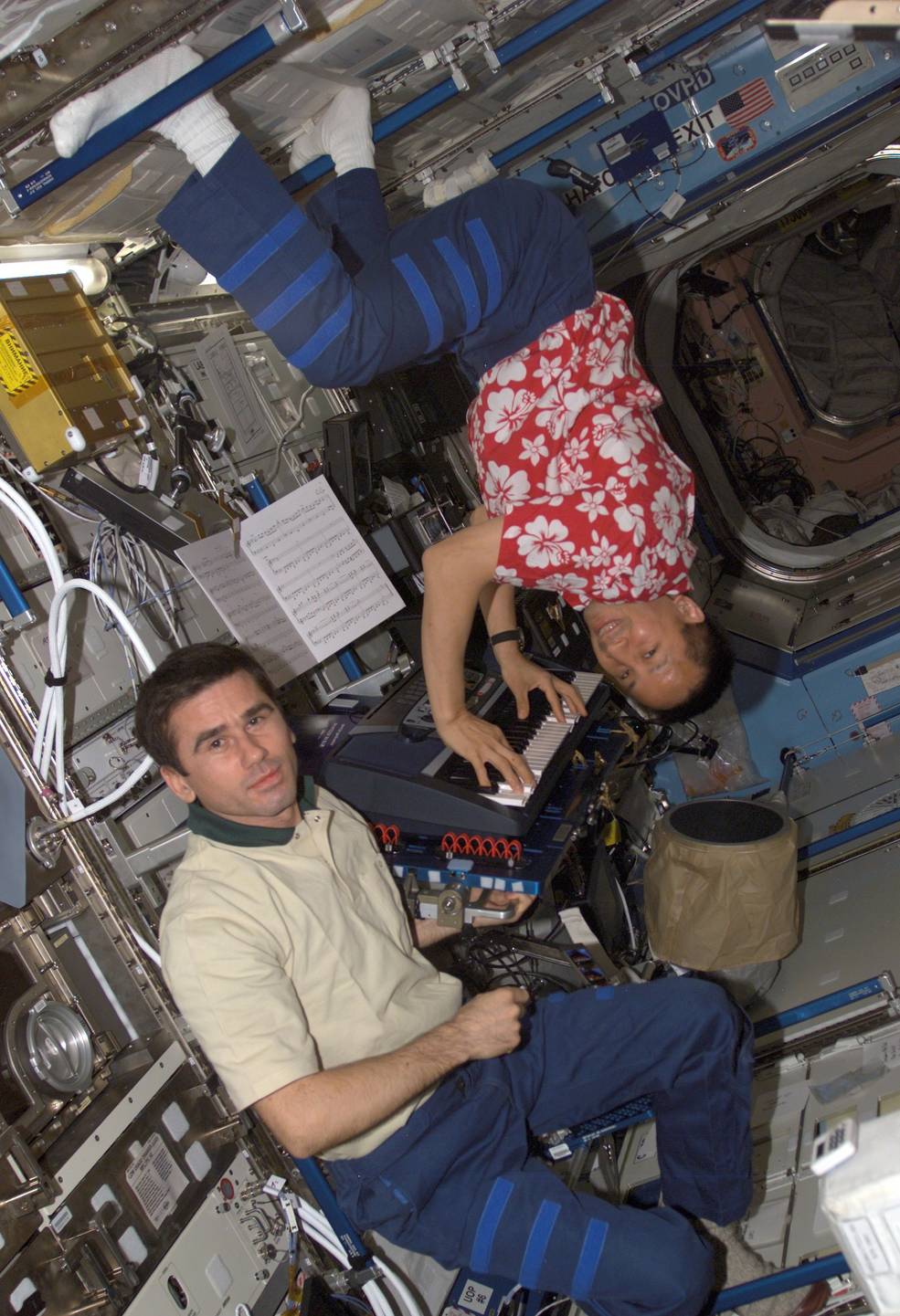
Far left: The International Space Station as it appeared in 2003. Second from left: NASA astronaut Edward T. Lu running on the treadmill he helped to install during STS-106. Second from right: Lu taking Earth photographs from the Zvezda module. Far right: Lu playing the keyboard while wearing one of his signature Aloha shirts.
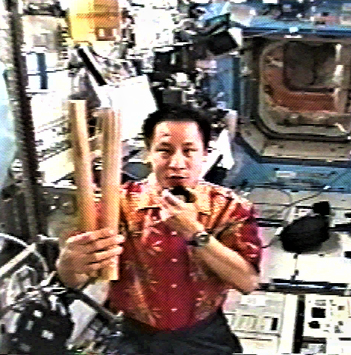
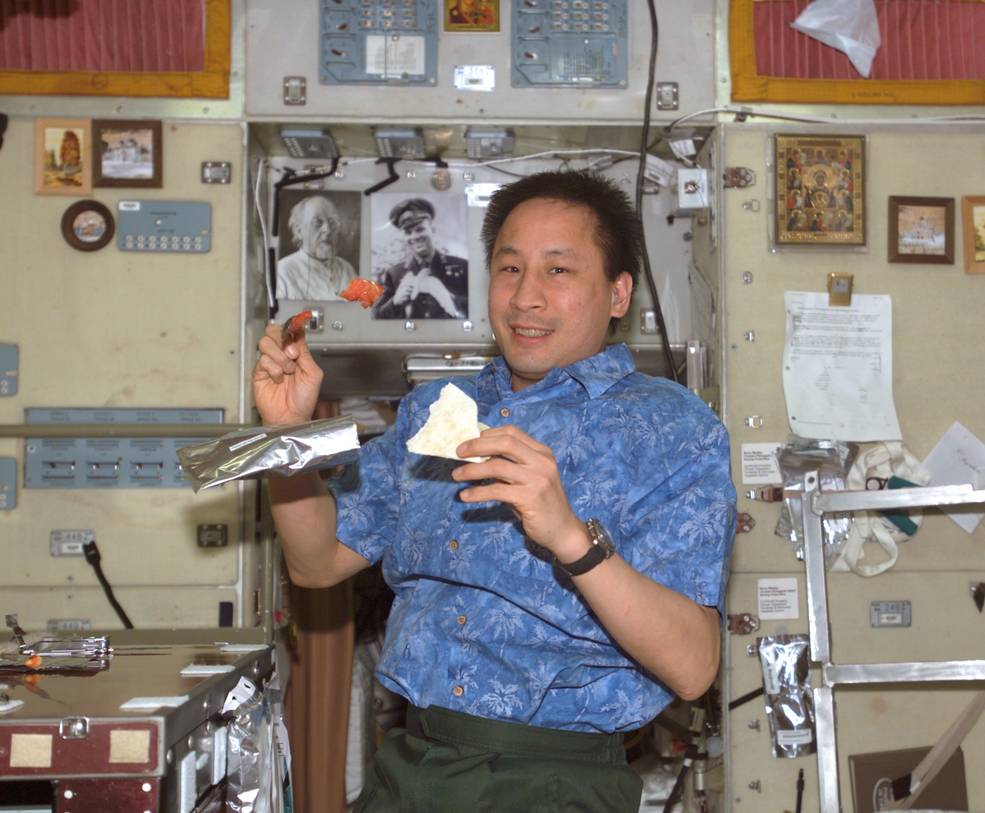
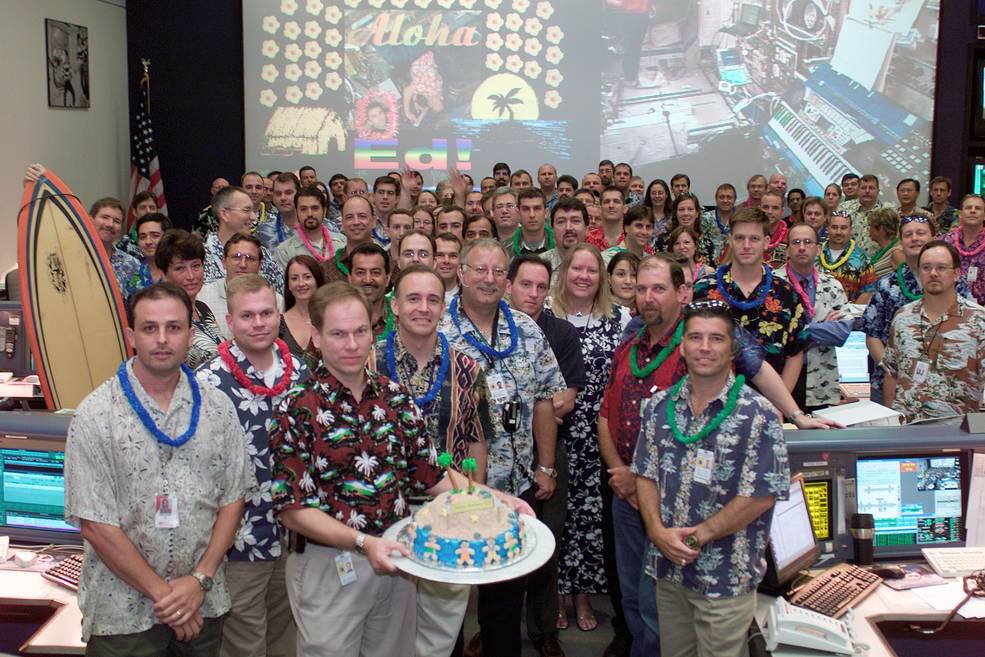
Left: NASA astronaut Edward T. Lu, wearing an Aloha shirt, demonstrating the Hawaiian pu’ili musical instruments for an educational activity. Middle: Lu, wearing an Aloha shirt, eating a snack. Right: Personnel in the Mission Control Center at NASA’s Johnson Space Center in Houston wearing Aloha shirts to celebrate Lu’s birthday.
By the time NASA astronaut Leroy Chiao made his first visit the space station, he had already flown two space shuttle missions, STS-65 and STS-72. During STS-92, he and his crewmates continued to prepare the station for its first occupants. Launching aboard Discovery on Oct. 11, 2000, they docked with the station two days later and began their assembly tasks. Chiao participated in two of the mission’s four spacewalks with crewmate NASA astronaut William S. McArthur to install the Z1 truss segment, the Space-to-Ground Antenna, Control Moment Gyros, and the third Pressurized Mating Adapter, spending more than 13 hours outside.
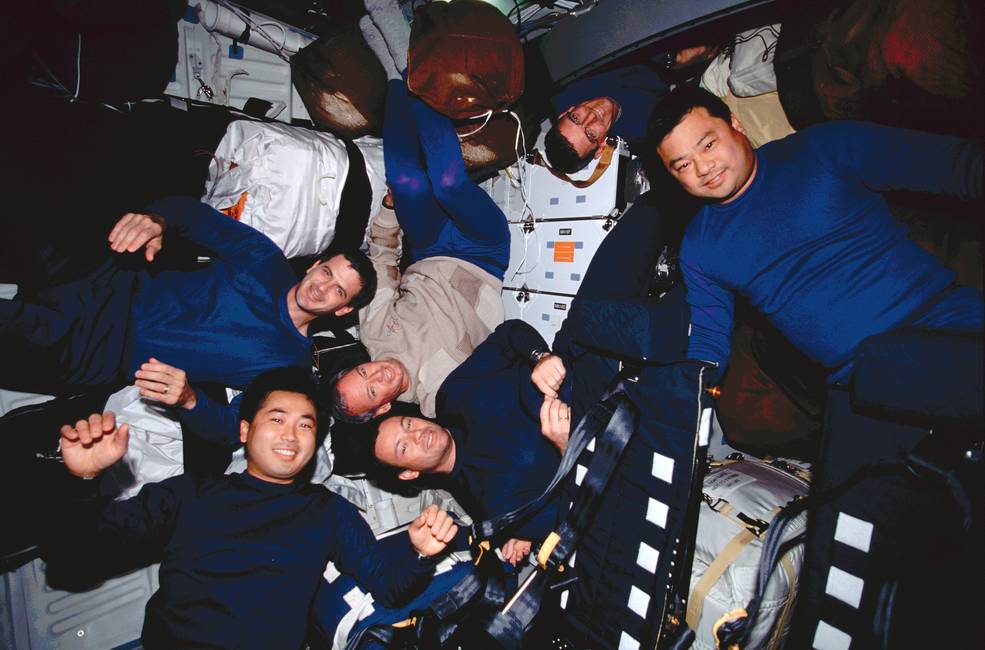
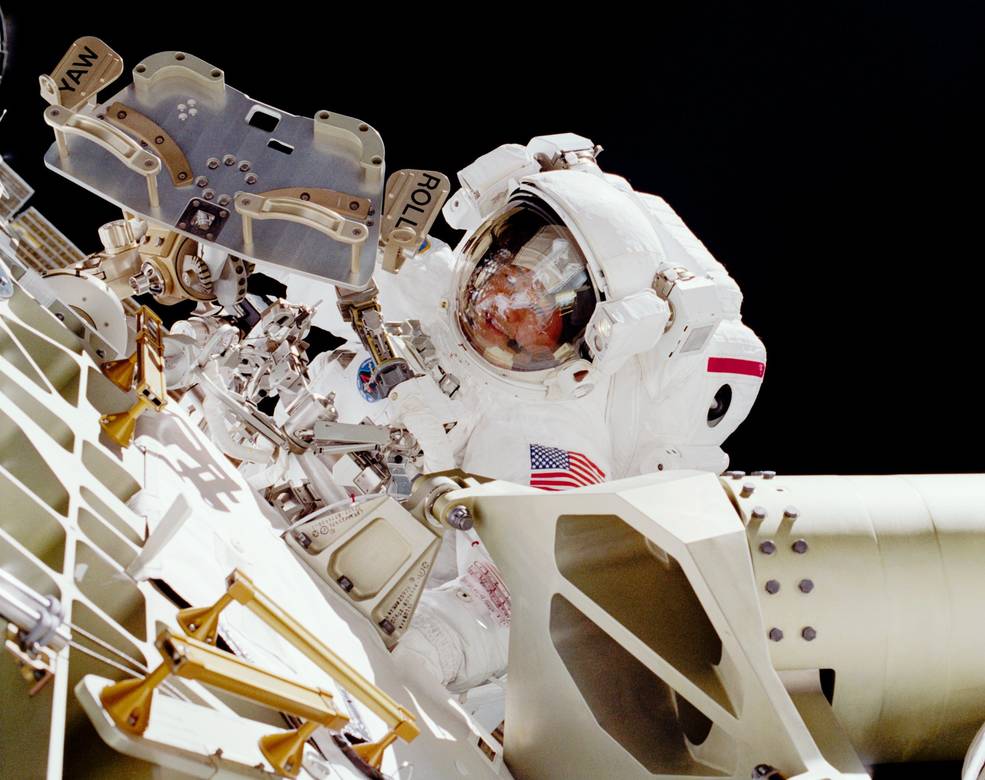
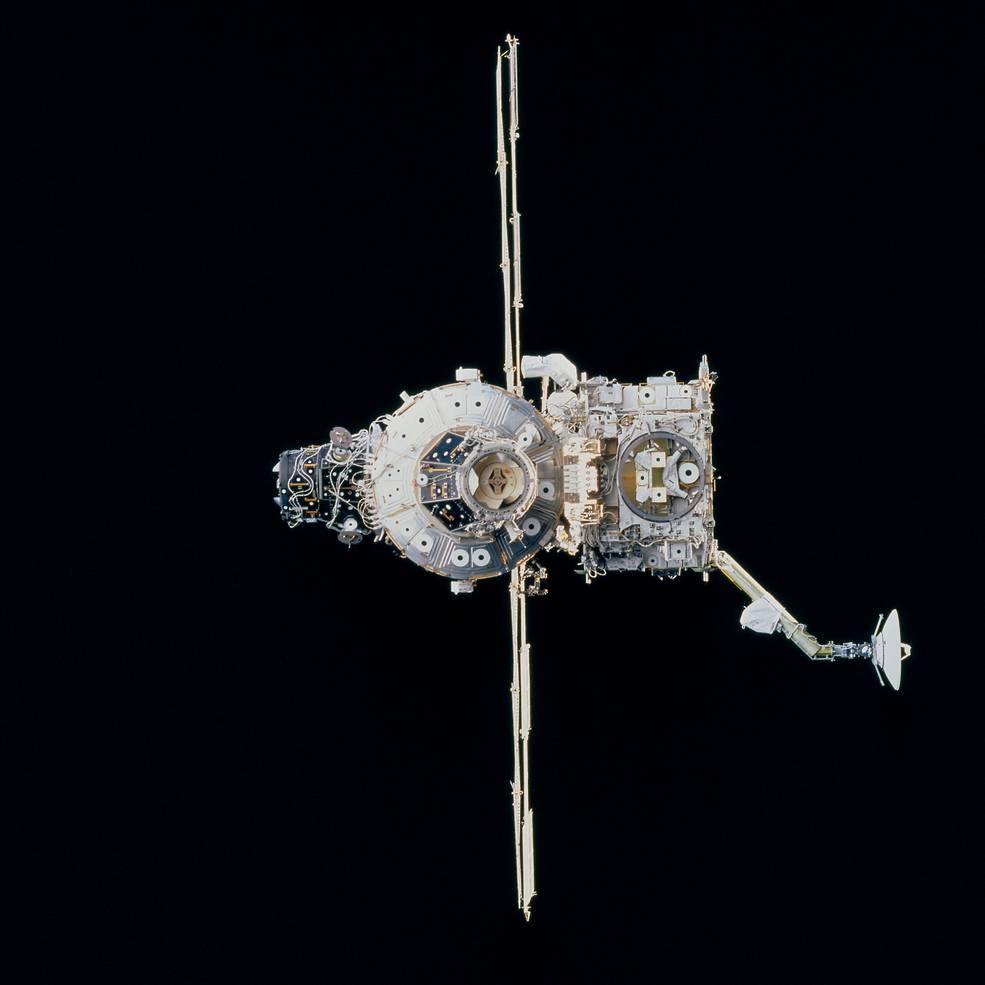
Left: NASA astronaut Leroy Chiao and his STS-92 crewmates in Discovery’s middeck.
Middle: Chiao during STS-92’s first spacewalk. Right: The space station as
it appeared with the addition of the Z1 truss and high-gain antenna.
For his second visit to the space station, Chiao went to stay, as Commander of Expedition 10. He and his crewmate, Russian cosmonaut Salizhan S. Sharipov, originally from Kyrgyzstan, launched aboard Soyuz TMA-5 on Oct. 14, 2004. The two conducted maintenance on the station and performed a pair of spacewalks. Part of Chiao’s research program involved ultrasound studies in microgravity. As a first, he submitted the results of the experiment to a scientific journal from the space station. Chiao and Sharipov landed back on Earth in April 2005 after 193 days in space.
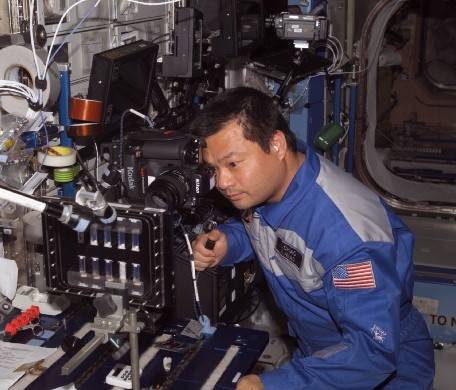
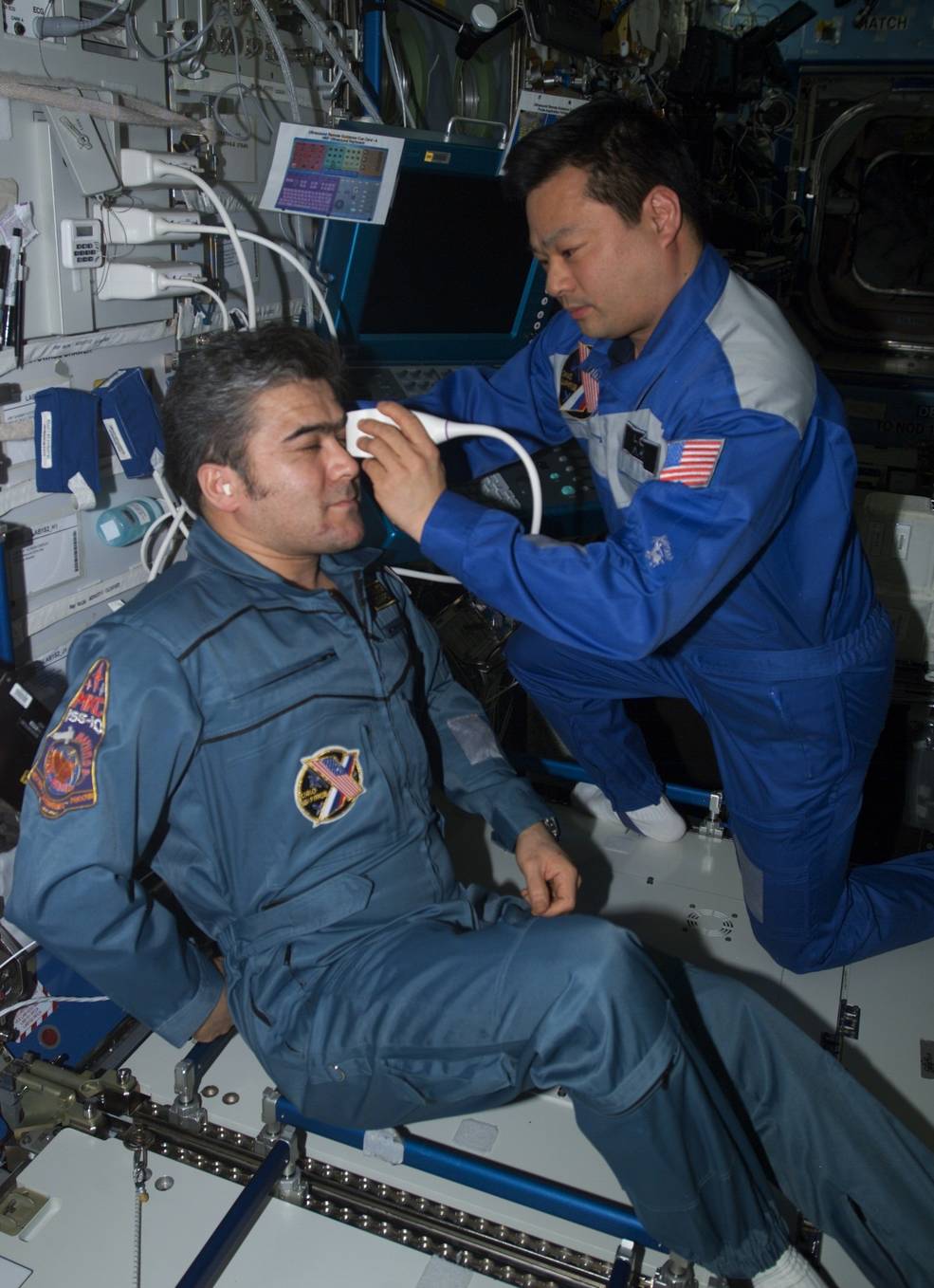
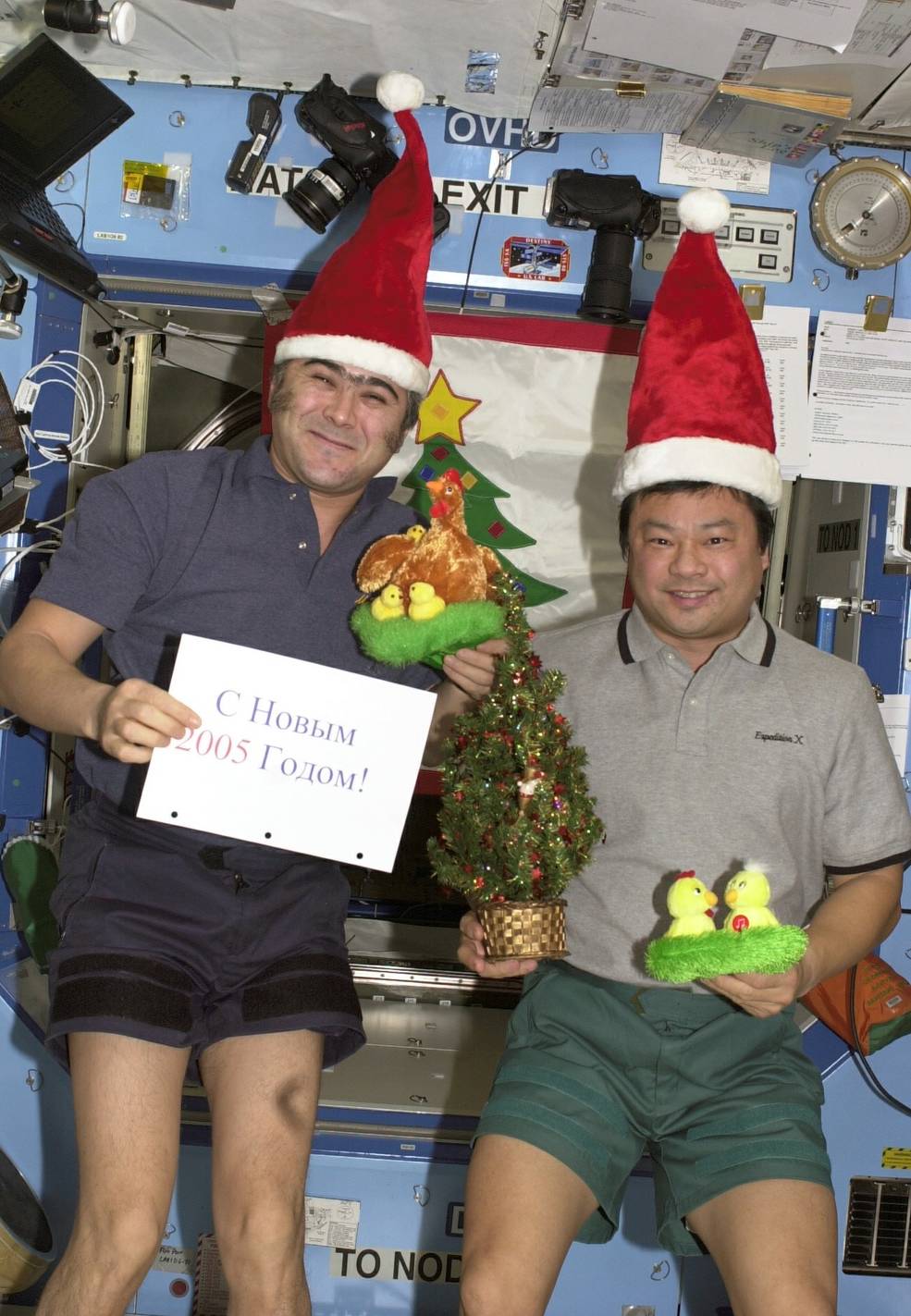
Left: NASA astronaut Leroy Chiao working on a colloid physics experiment in
the Destiny module. Middle: Chiao, right conducting an ultrasound examination
on Russian cosmonaut Salizhan S. Sharipov. Right: Holiday season aboard
the space station during Expedition 10.
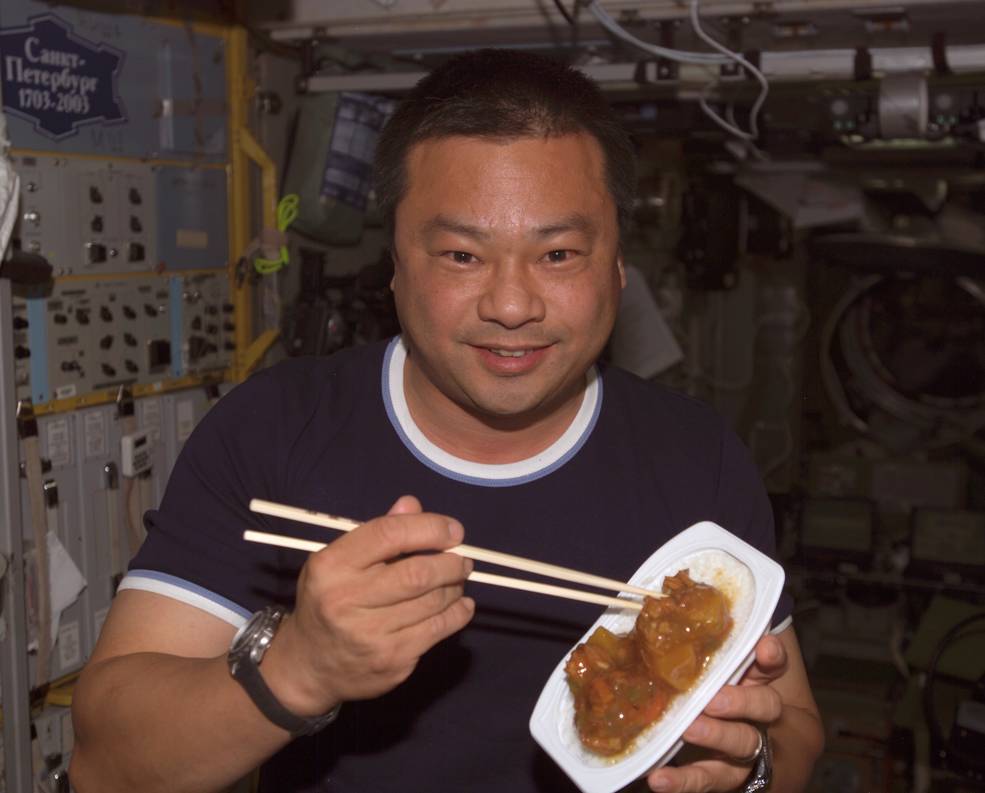
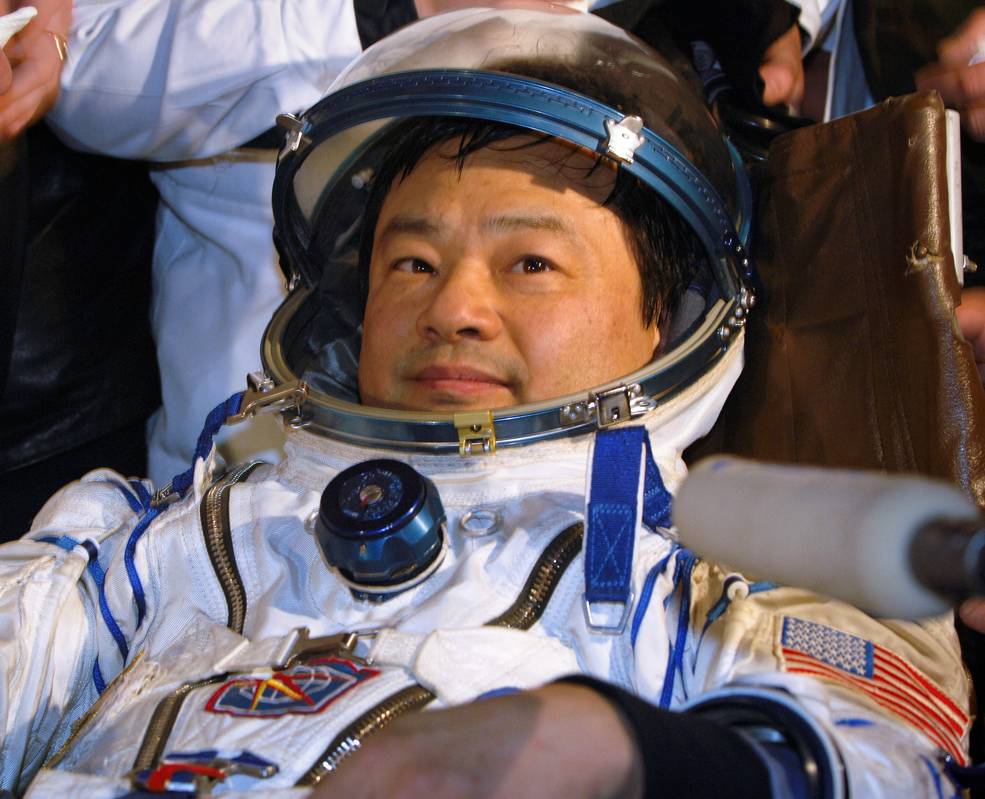
Left: NASA astronaut Leroy Chiao enjoying a meal aboard the space
station. Right: Chiao shortly after landing back on Earth.
On his first spaceflight, Mark L. Polansky served as pilot of STS-98, the mission that delivered the U.S. Laboratory Module Destiny to the space station in February 2001. In addition to accommodating research facilities and life support systems, Destiny significantly increased the station’s habitable volume. Atlantis’ astronauts performed three spacewalks to complete the installation of the module, which they jointly dedicated with the Expedition 1 crew of NASA astronaut William M. Shepherd and Russian cosmonauts Yuri P. Gidzenko and Sergei K. Krikalev, nearing the end of history-making mission.
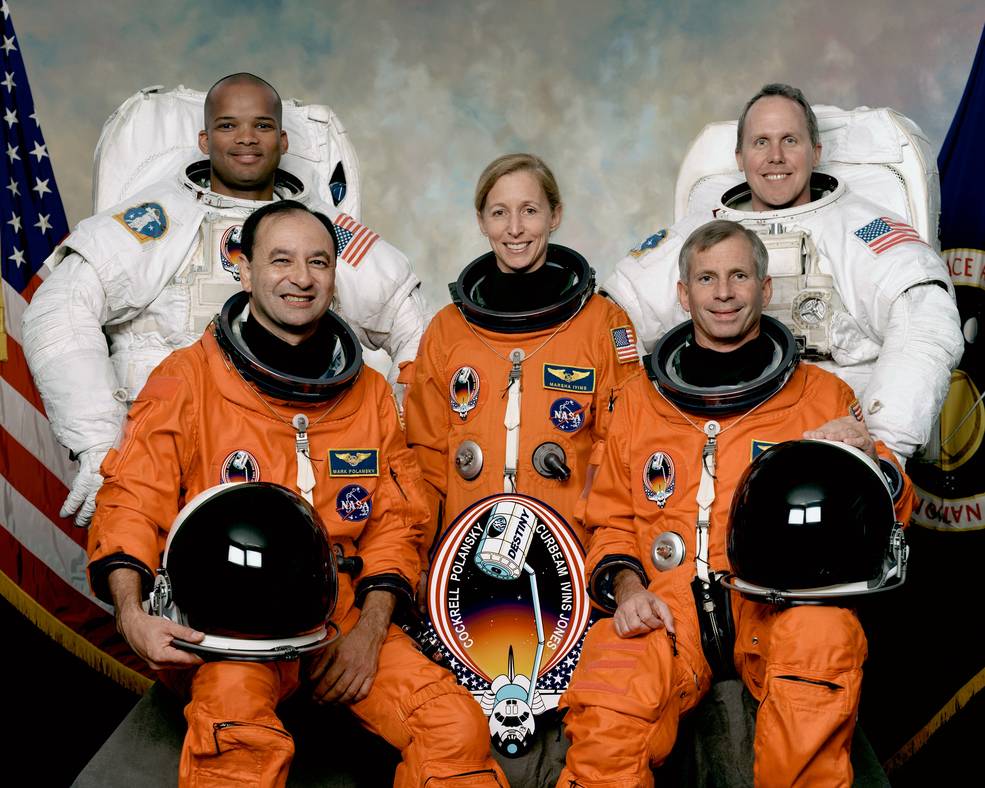

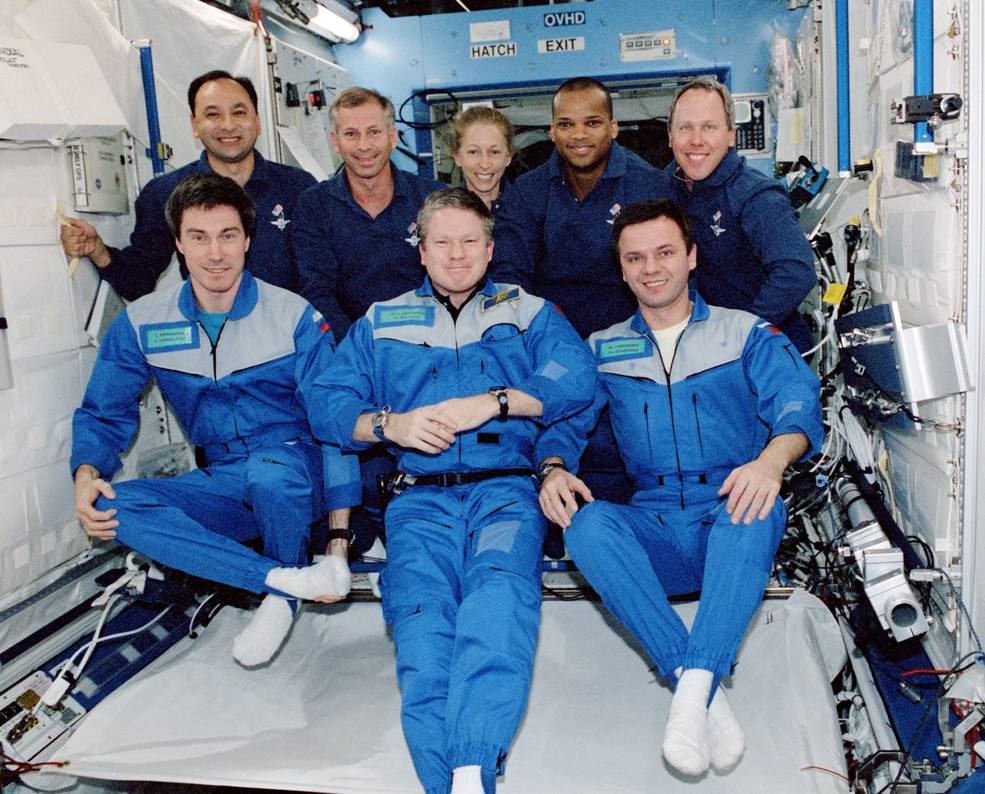
Left: NASA astronaut Mark L. Polansky, front row, left, with his STS-98 crewmates. Middle: The robotic arm lifting the Destiny module from Atlantis’ payload bay. Right: Polansky, back row, left, with his STS-98 crewmates and the Expedition 1 crew in the newly delivered Destiny module.
For his second visit to the space station in December 2006, Polansky served as commander of STS-116, the flight that delivered the P5 truss segment to the orbital laboratory. The first post-Columbia crew rotation took place during STS-116, in which NASA astronaut Sunita L. “Suni” Williams replaced European Space Agency (ESA) astronaut Thomas Reiter on the Expedition 14 crew. The STS-116 astronauts conducted four spacewalks to install and connect the P5 truss and to reconfigure the station’s electrical power channels, some of the most complex tasks ever accomplished in space.
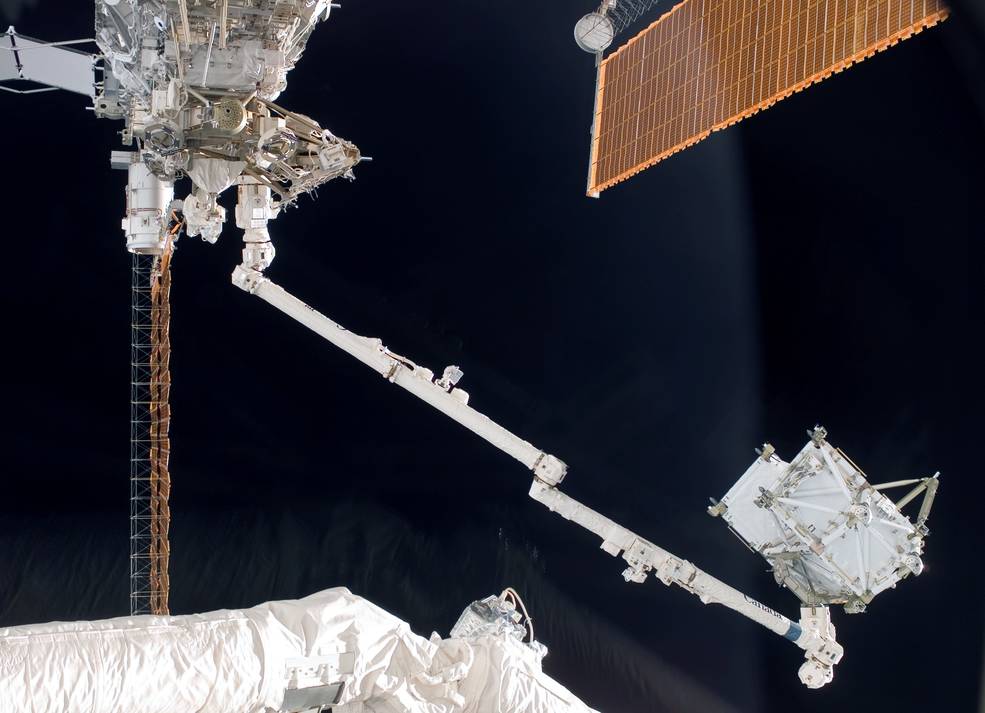
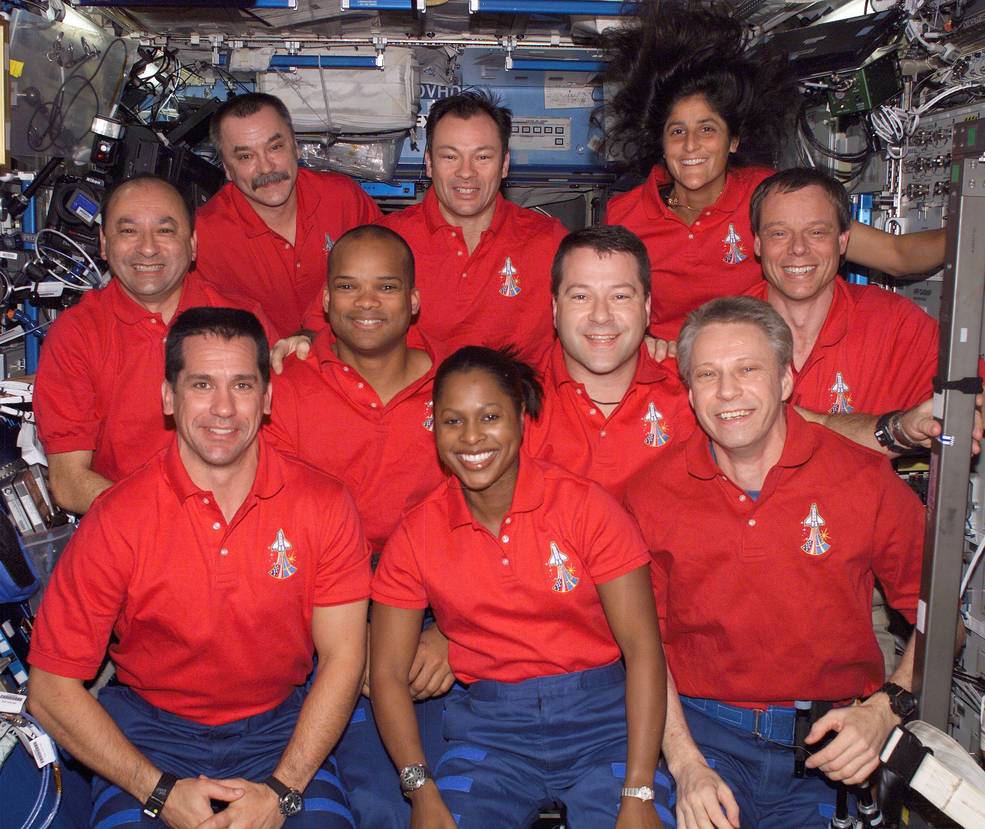
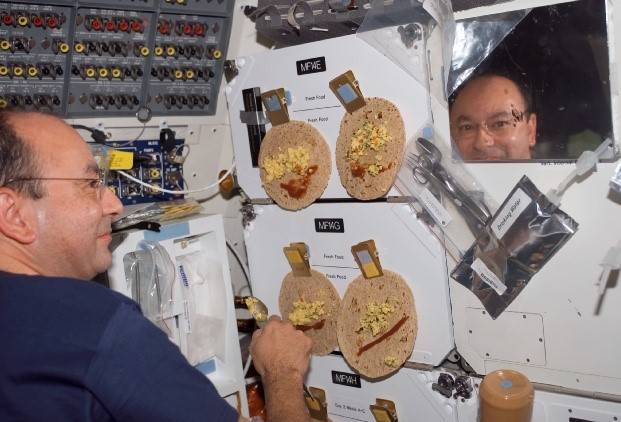
Left: The station’s robotic arm lifting the P5 truss segment out of Discovery’s payload bay. Middle: NASA astronaut Roman L. Polansky, middle row, left, with his STS-116 crewmates and the Expedition 14 crew. Right: Polansky preparing breakfast burritos in Discovery’s middeck.
Polansky once again served as commander for his third and final visit to the space station, STS-127 in July 2009. During this mission, space shuttle Endeavour delivered the Exposed Facility for the Kibo Japanese Experiment Module (JEM-EF), a platform for hosting external payloads. Several members of the crew completed five spacewalks to perform a variety of assembly and maintenance tasks. As part of a crew rotation, NASA astronaut Timothy L. Kopra replaced Japan Aerospace Exploration Agency (JAXA) astronaut Koichi Wakata on the Expedition 20 crew.
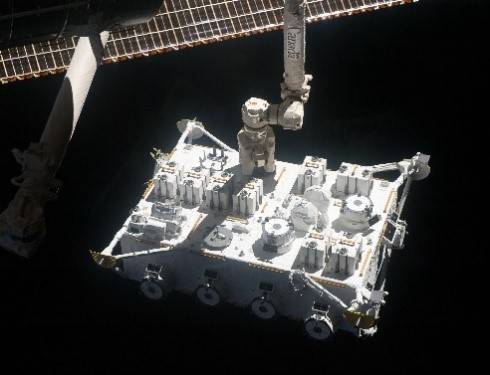
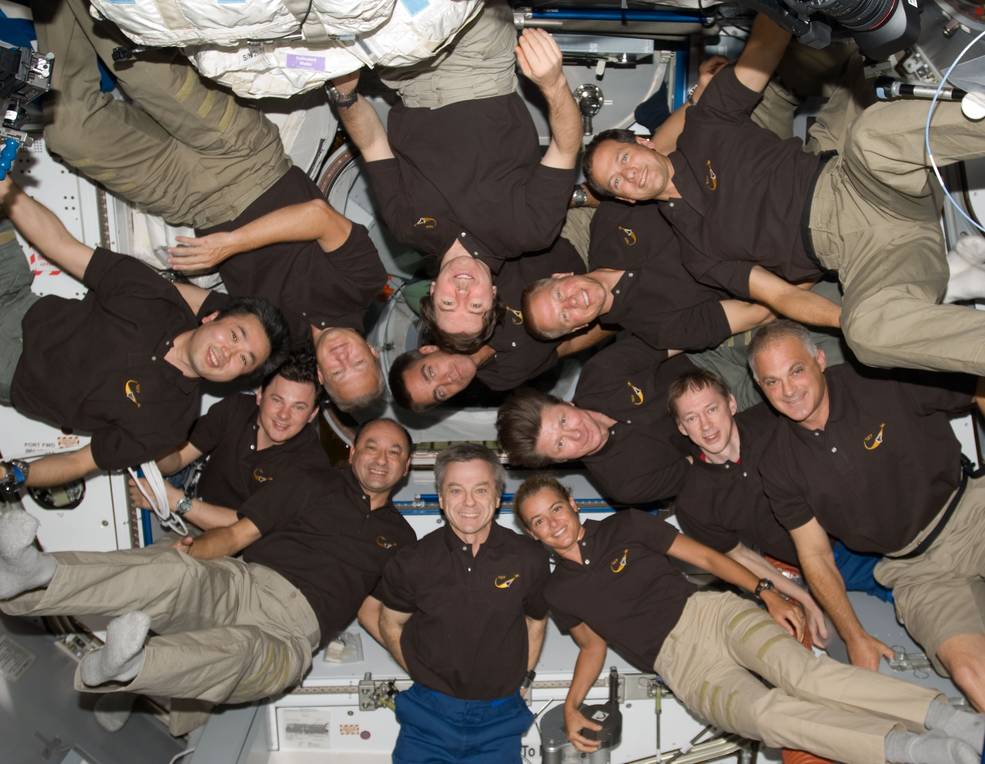
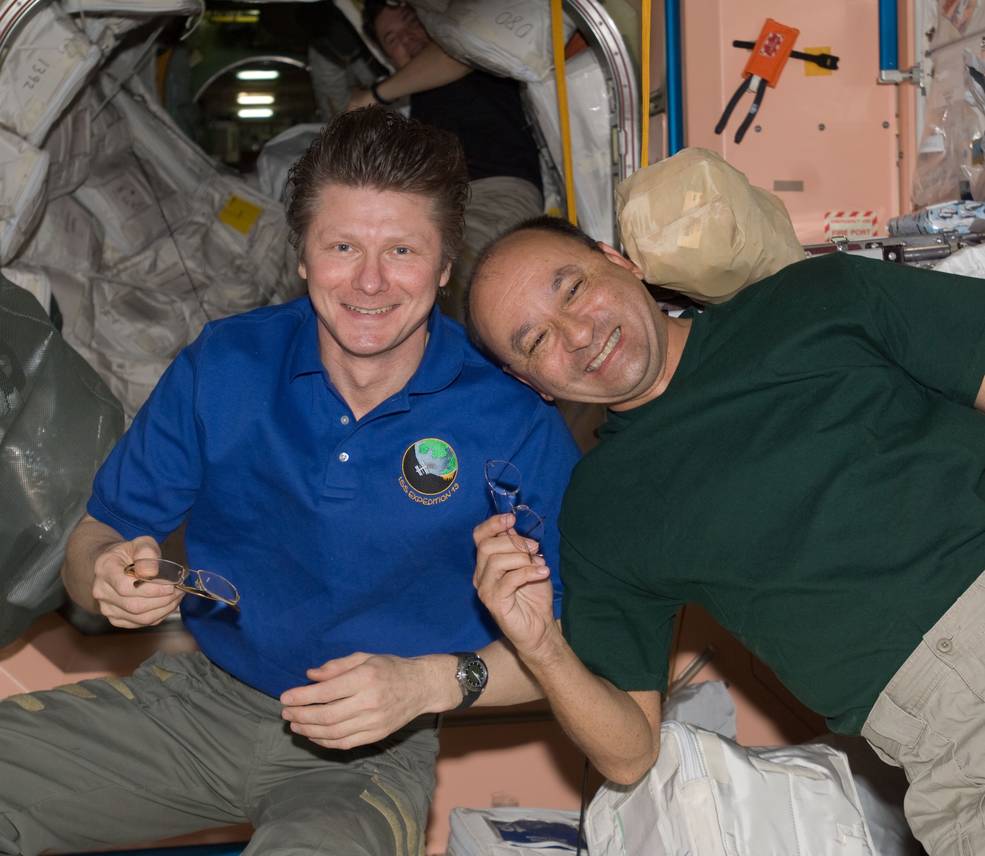
Left: The station’s robotic arm lifts the Japanese Experiment Module’s Exposed Facility from the shuttle’s payload bay. Middle: NASA astronaut Mark L. Polansky, lower left, with his STS-127 crewmates and the Expedition 20 crew. Right: Polansky, right, and Expedition 20 commander Russian cosmonaut Gennadi I. Padalka comparing their eyeglasses.
NASA astronaut Daniel M. Tani completed his first space flight during the STS-108 mission. Launched on Dec. 5, 2001, space shuttle Endeavour carried the Rafaello Multi-Purpose Logistics Module (MPLM) in its payload bay, bringing supplies and scientific equipment to the station. Tani completed a 4-hour spacewalk with fellow NASA astronaut Linda M. Godwin to install insulation blankets on the station’s solar array rotary joints. The mission also completed the handover between the Expedition 3 and 4 crews.
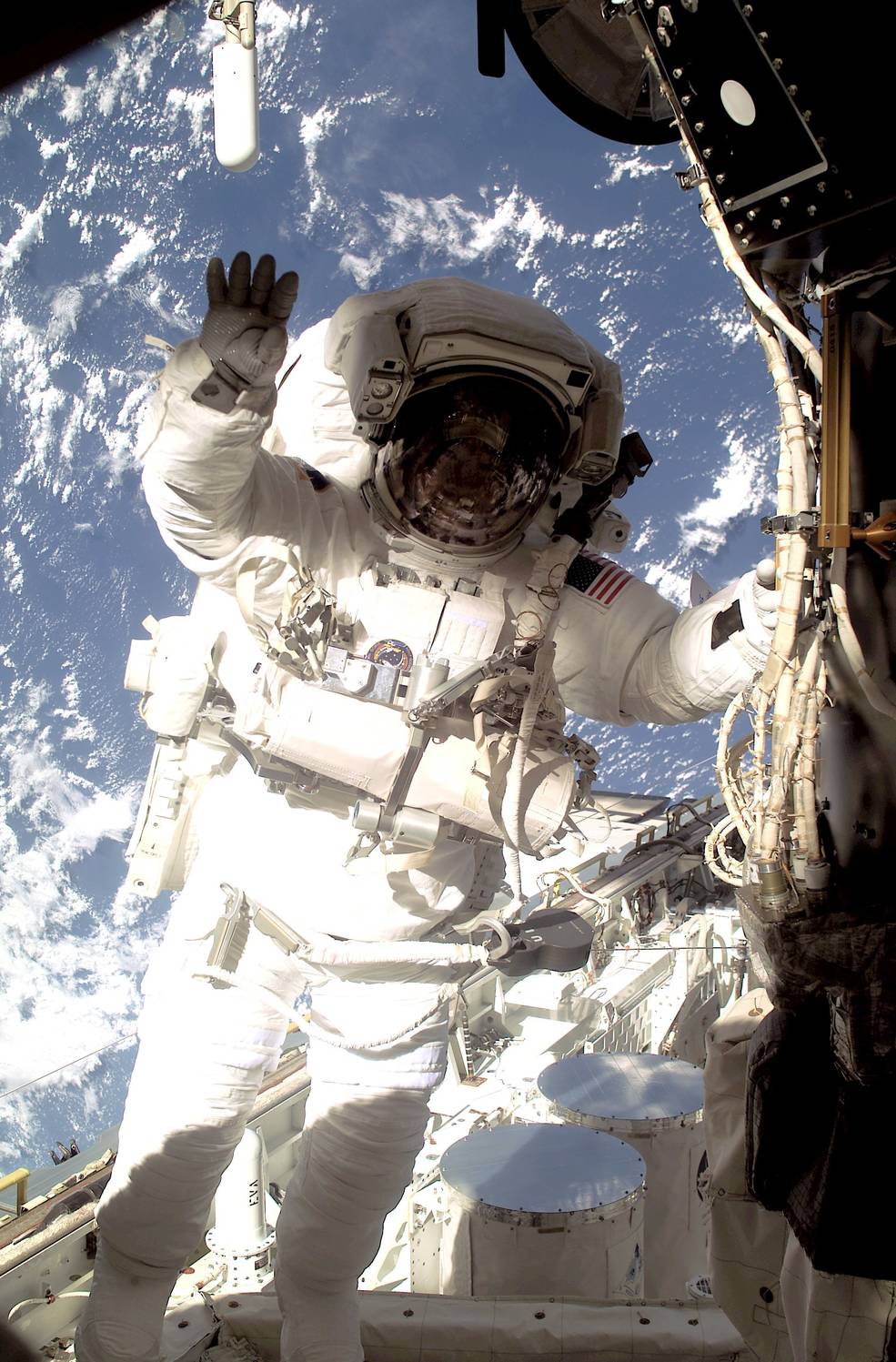
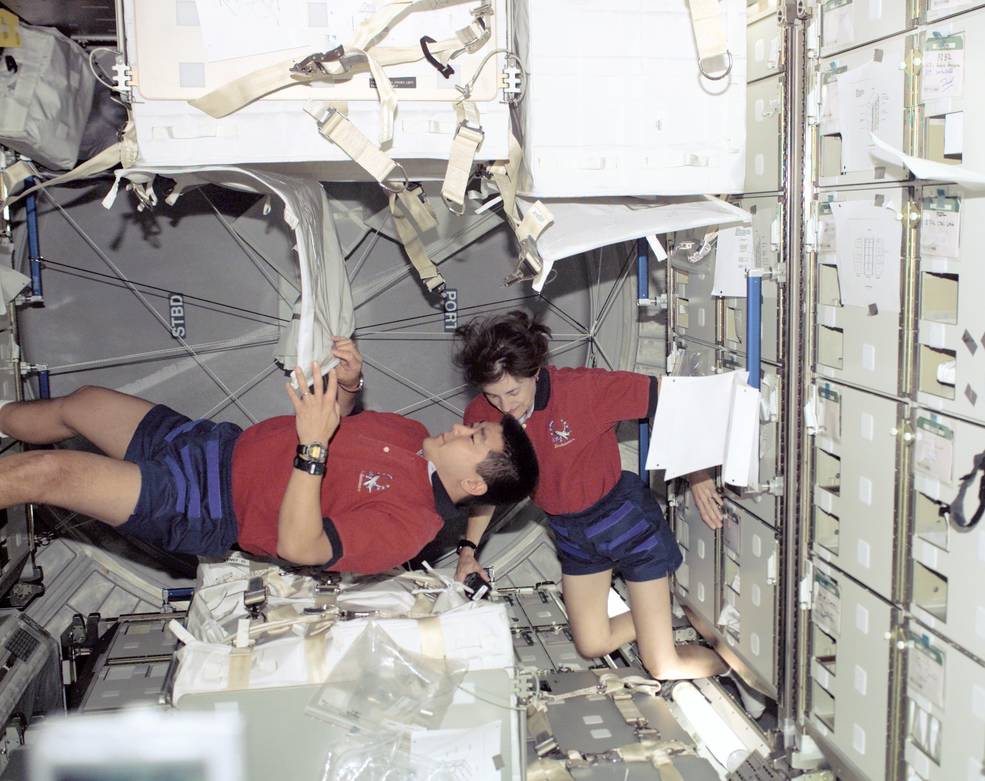
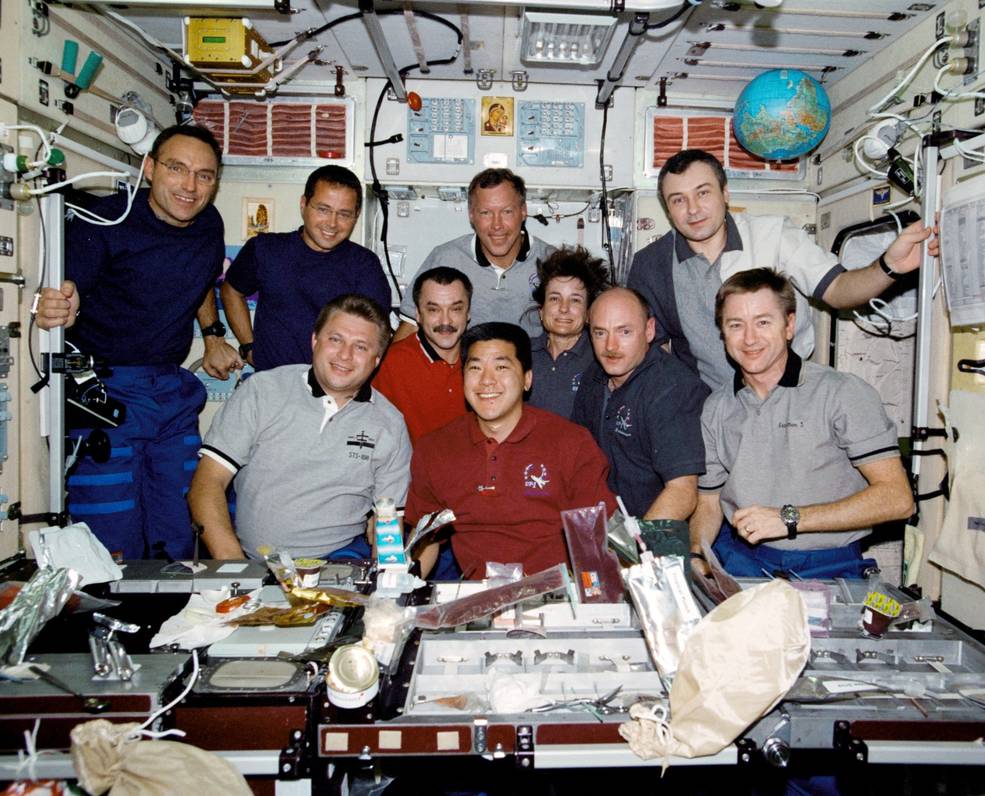
Left: NASA astronaut Daniel M. Tani waves during his STS-108 spacewalk. Middle: Tani, left, with STS-108 crewmate NASA astronaut Linda M. Godwin inspecting stowage bags in the Multi-Purpose Logistics Module. Right: Tani, front row, center, with his STS-108 crewmates and the Expedition 3 and 4 crews.
Next up for Tani was a long-term visit to the space station as a member of Expedition 16. He launched as part of the STS-120 crew on Oct. 23, 2007, the flight of Discovery that brought the Harmony Node 2 module to the station. A critical element, Node 2 served as a hub for the addition of the European and Japanese research modules. With Discovery still docked to the station, Tani conducted one spacewalk with fellow NASA astronaut Scott E. Parazynski to disconnect the P6 truss segment from its Z1 location prior to its robotic relocation to the main station truss. After joining the Expedition 16 crew, having exchanged places with NASA astronaut Clayton C. Anderson, Tani performed five stage spacewalks with station commander NASA astronaut Peggy A. Whitson to finish the installation of the Harmony module. Swapping places with ESA astronaut Léopold P. Eyharts, Tani returned to Earth in February 2008 during the STS-122 mission of Atlantis, the flight that brought the European Columbus research module to the orbiting laboratory. His efforts helped to greatly enlarge the station’s capabilities. During his two flights, Tani spent 132 days in space and 39 hours on spacewalks.
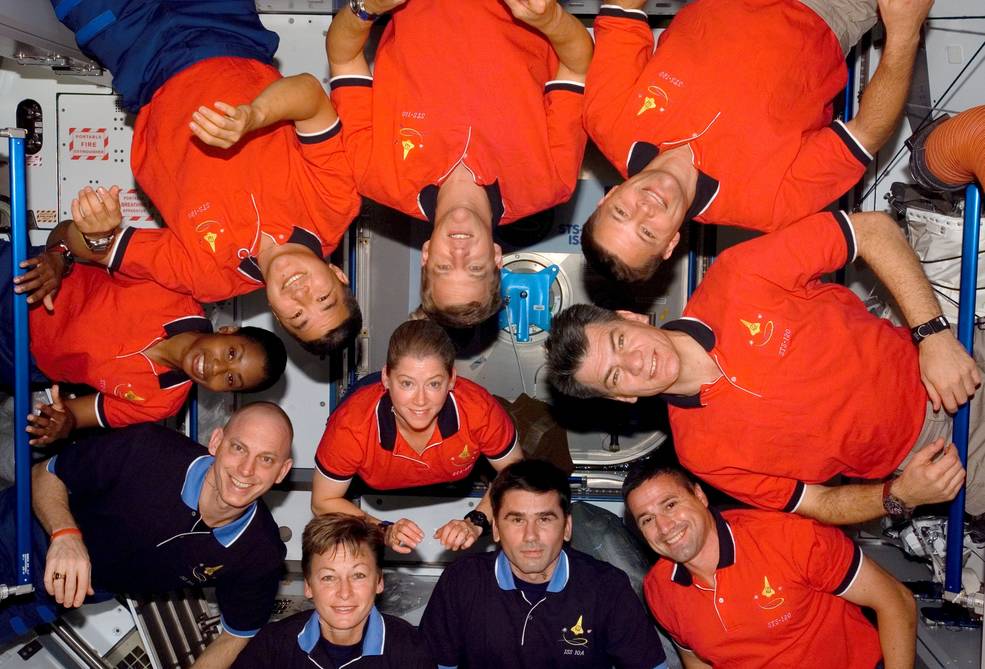
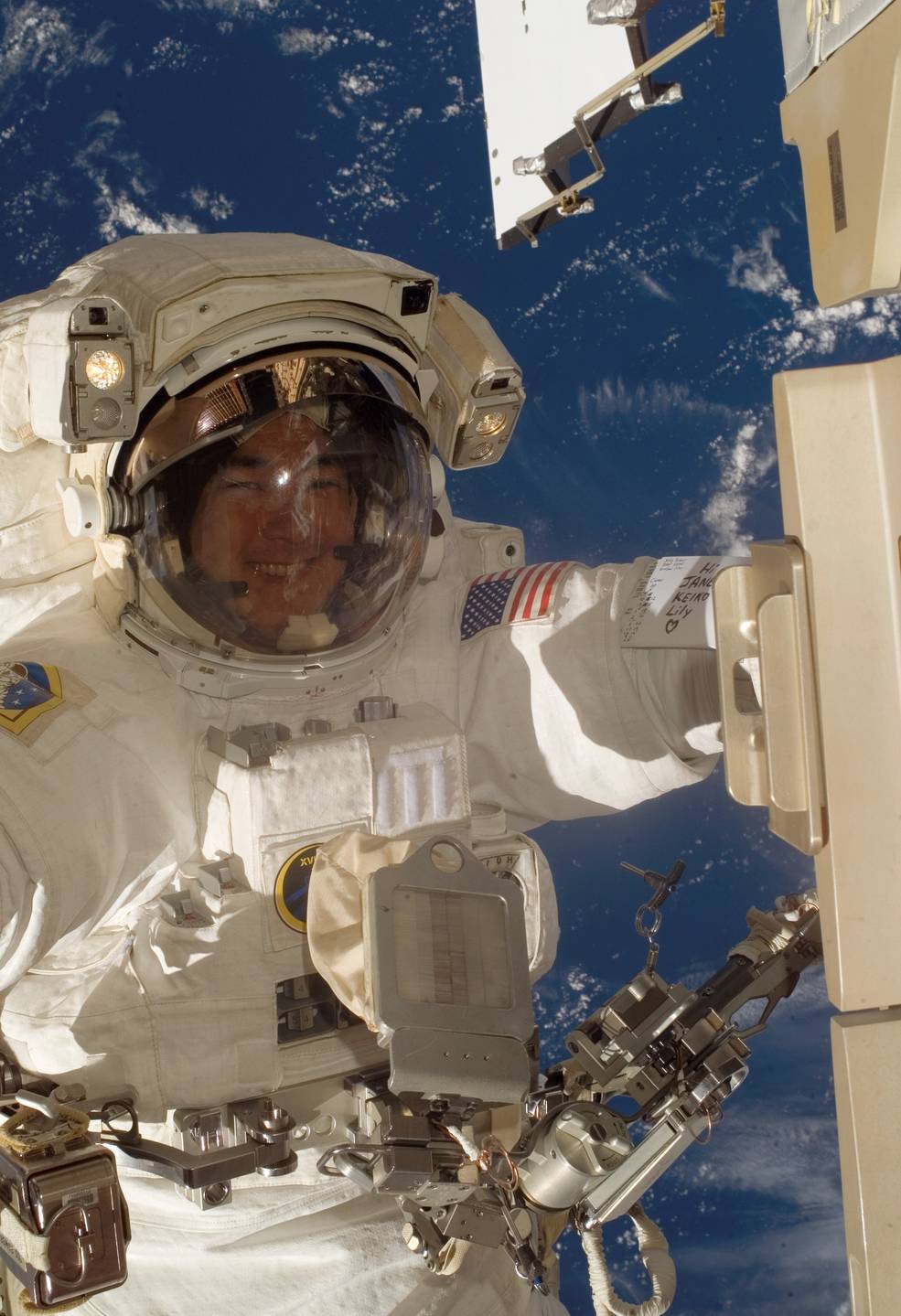
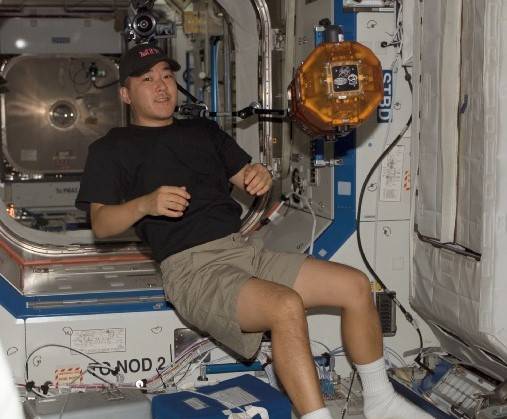
Left: NASA astronaut Daniel M. Tani, upper left, with his STS-120 crewmates and the Expedition 16 crew he was about join. Middle: Tani during his fourth Expedition 16 spacewalk. Right: Tani works with the SPHERES experiment in the Destiny module.
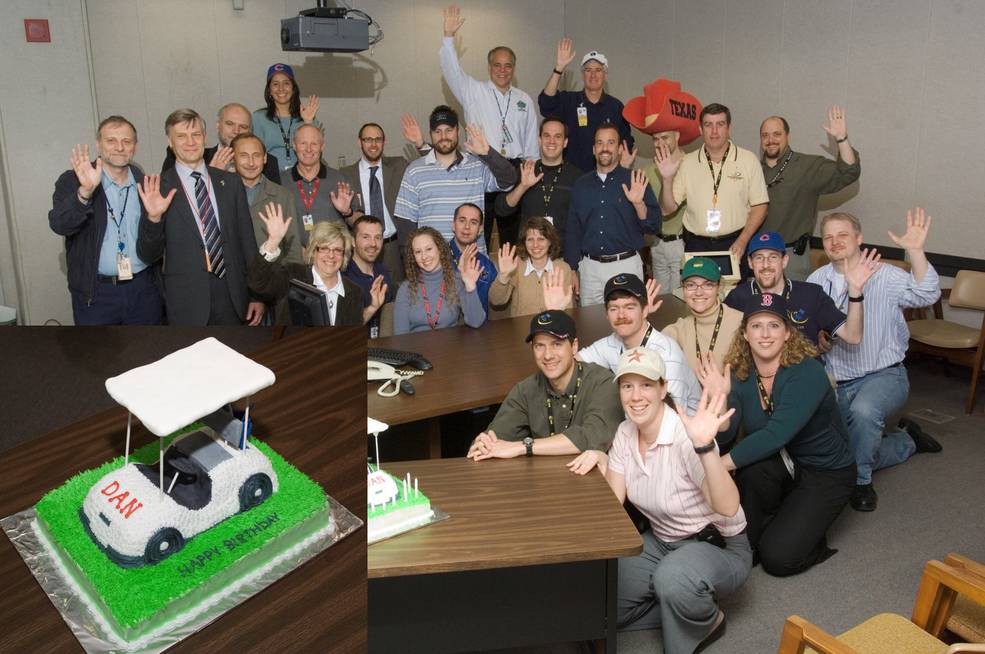
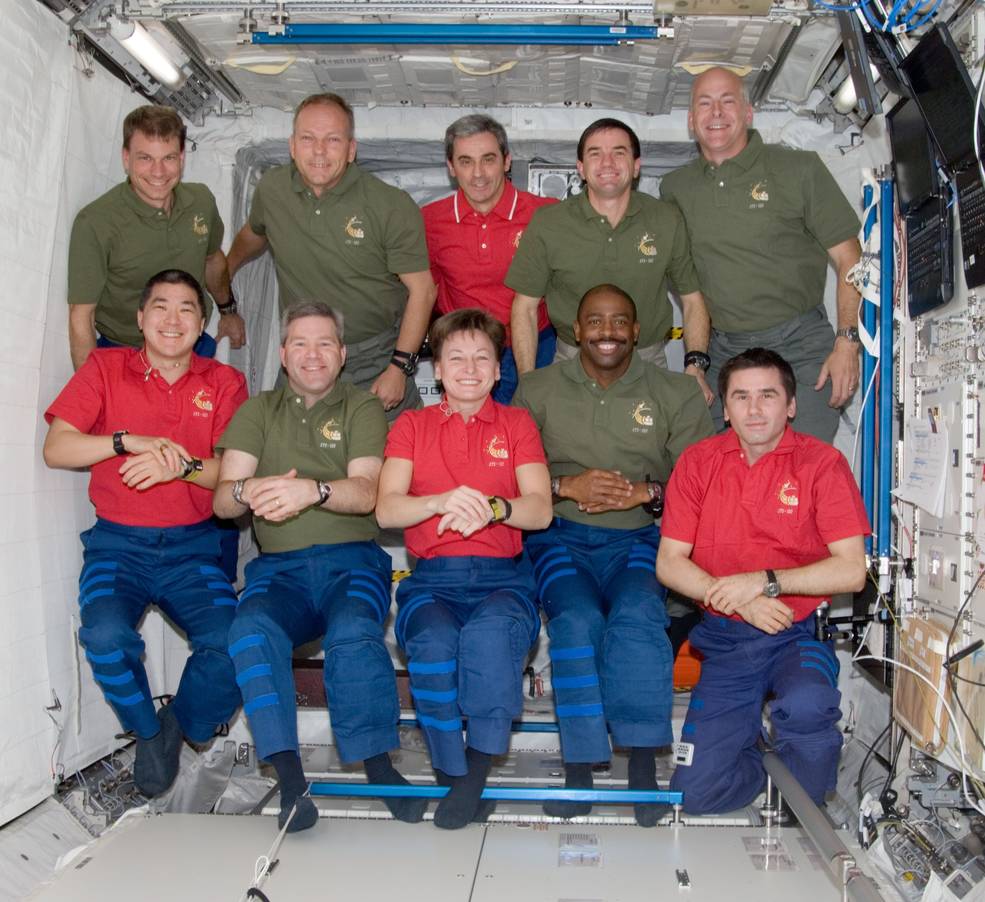
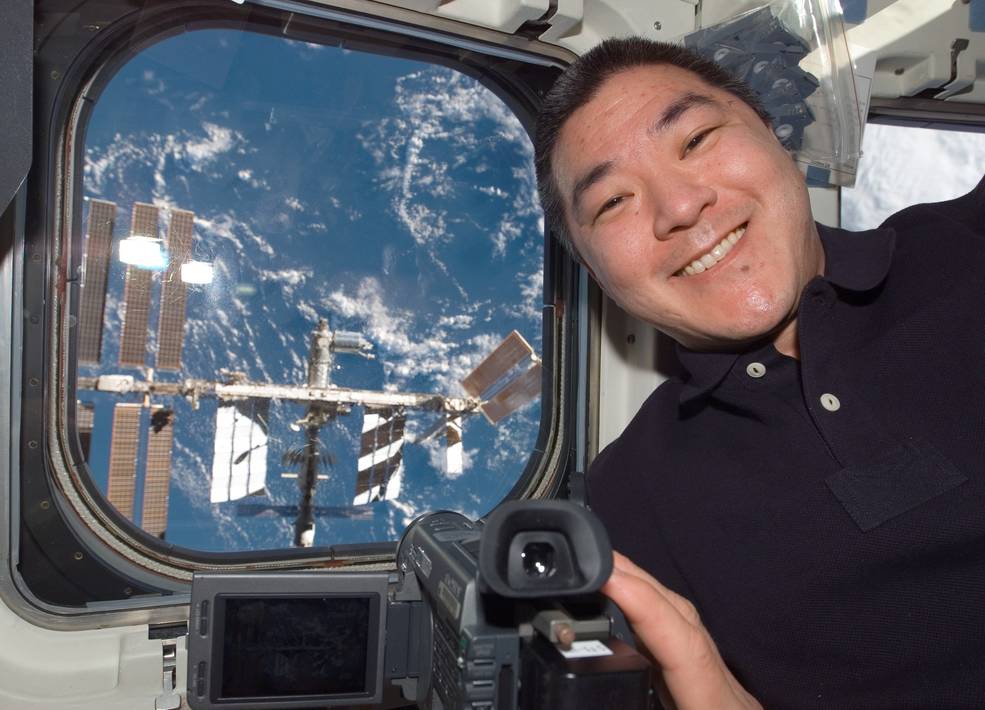
Left: Personnel in the Mission Control Center at NASA’s Johnson Space Center in Houston wish astronaut Daniel M. Tani a happy birthday – inset shows a close-up of his golf cart-shaped birthday cake. Middle: Tani, front row at left, with his Expedition 16 crewmates and the STS-122 crew he was about to join. Right: Tani on Discovery’s flight deck with the space station seen through the window – the Node 2 and Columbus modules added during his stay are visible.
During his record-tying seventh trip into space, NASA astronaut Franklin R. Chang-Díaz made his only visit to the space station. The main goals of Endeavour’s STS-111 mission, launched on June 5, 2002, included the exchange of the Expedition 4 and 5 crews and the resupply of the orbiting facility using the Leonardo MPLM. The resupply module’s cargo included two new research facilities. Chang-Díaz completed three spacewalks with crewmate French astronaut Philippe Perrin to install the Mobile Base System portion of the Canadarm2’s remote manipulator system and perform maintenance tasks on the space station.
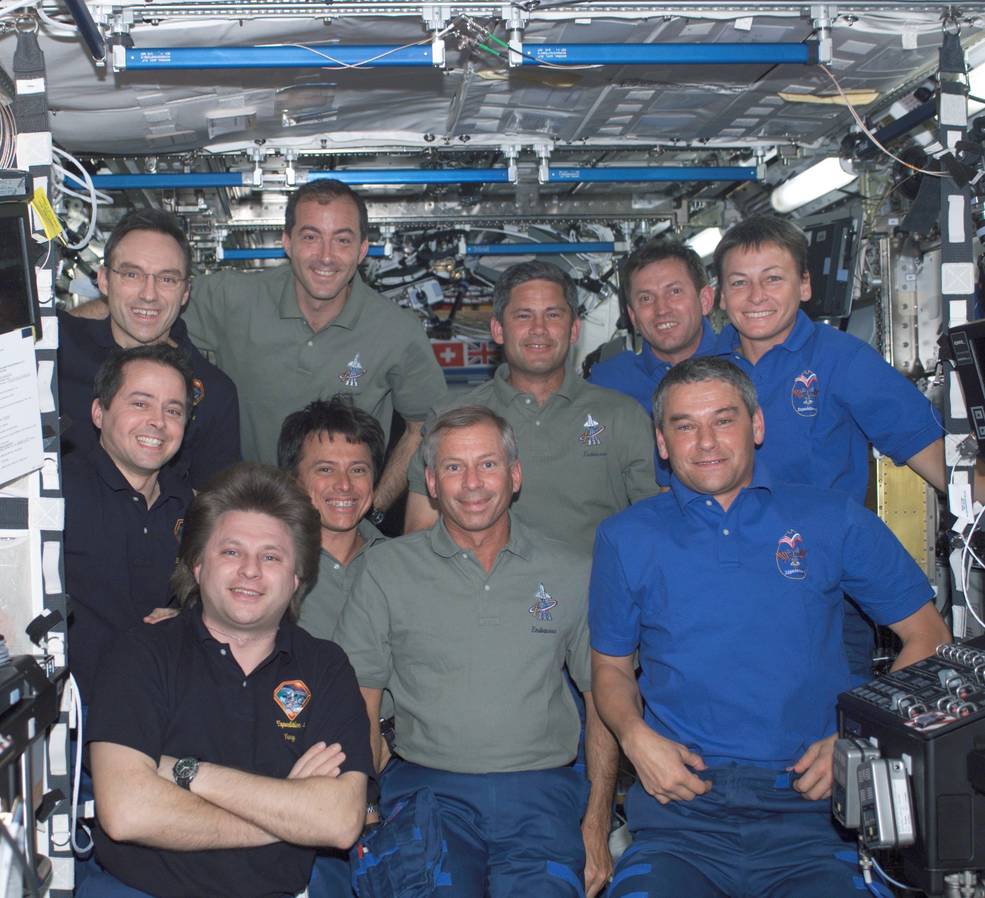
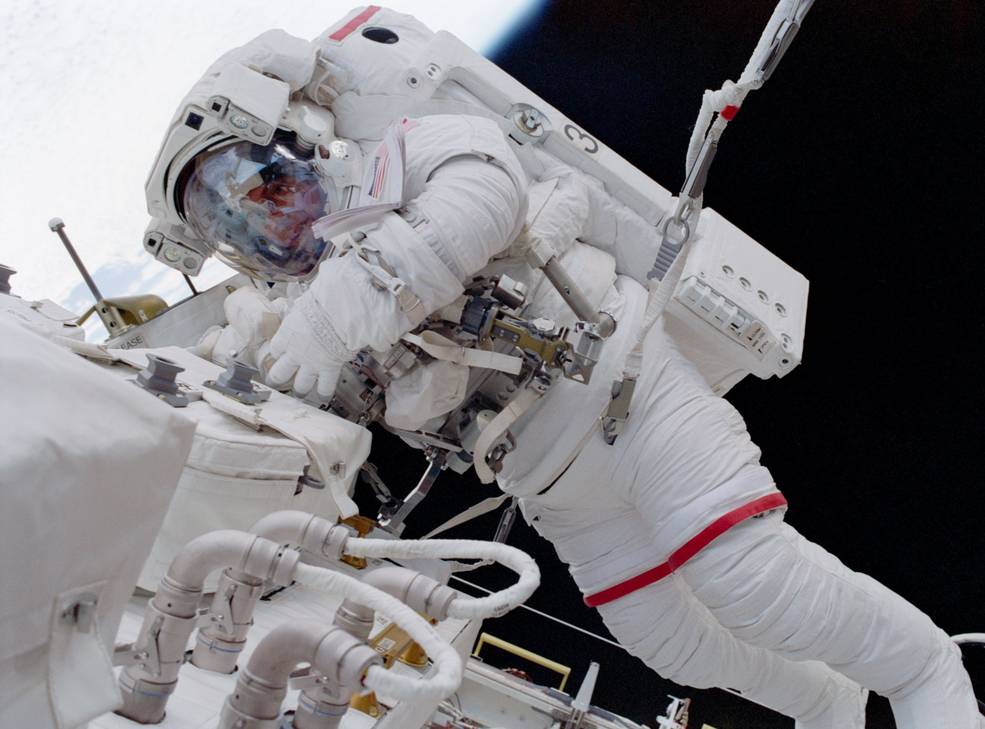
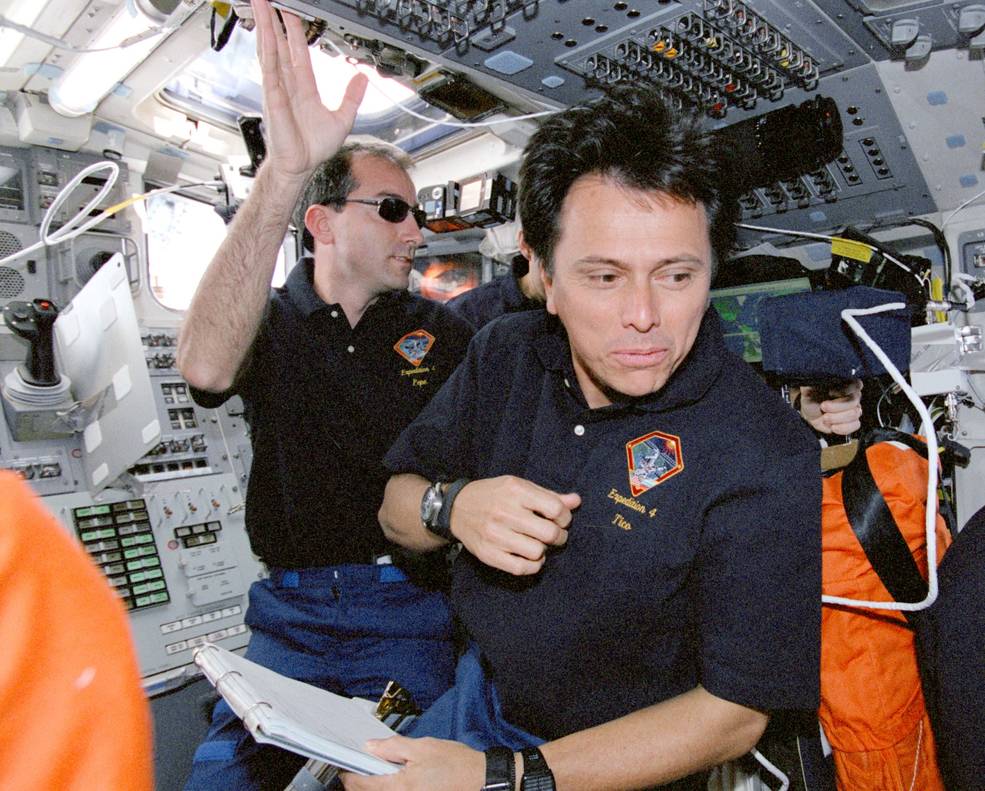
Left: NASA astronaut Franklin R. Chang-Díaz, to left of center, with his STS-111 crewmates and the Expedition 4 and 5 crews. Middle: Chang-Díaz during the first STS-111 spacewalk. Right: Chang-Díaz in Endeavour’s middeck following undocking from the orbiting outpost.
As noted above, NASA astronaut Suni Williams arrived at the space station with STS-116 in December 2006 during one of the busiest and most complex periods of assembly. In addition to the arrival of new truss segments, the astronauts reconfigured the station’s power system. While still a Shuttle crewmember, Williams participated in one of the spacewalks with fellow NASA astronaut Robert L. Curbeam as part of the power reconfiguration. She joined the Expedition 14 crew, replacing ESA astronaut Reiter, as only the third female space station long-duration crewmember. With Expedition 14 commander NASA astronaut Michael E. Lopez-Alegria she performed three more spacewalks to complete the activation of the station’s ammonia cooling system. In April 2007, during her transition to the Expedition 15 crew, Williams “ran” the Boston Marathon on the station’s treadmill, wearing number 14000 and finishing in 4 hours, 24 minutes. She exchanged places with NASA astronaut Anderson during the STS-117 mission that delivered the S3/S4 truss and a new pair of solar arrays to the station. Williams returned to Earth after 191 days in space, at the time the longest flight by a woman. The more than 29 hours she spent outside on her four spacewalks also set a record for women.
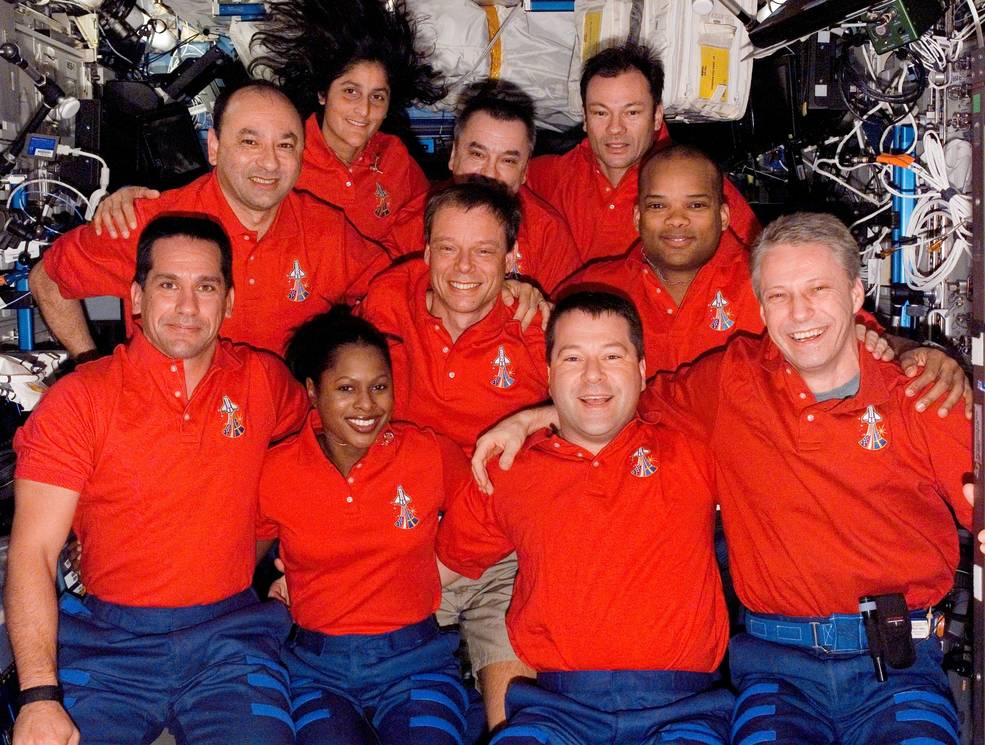
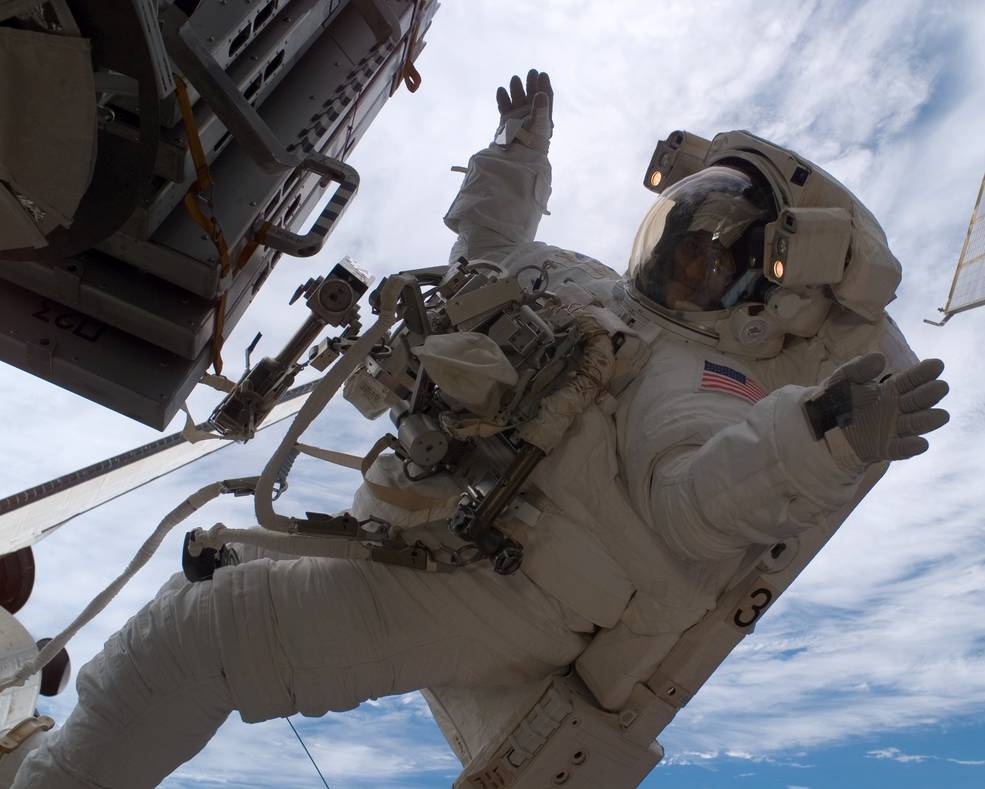
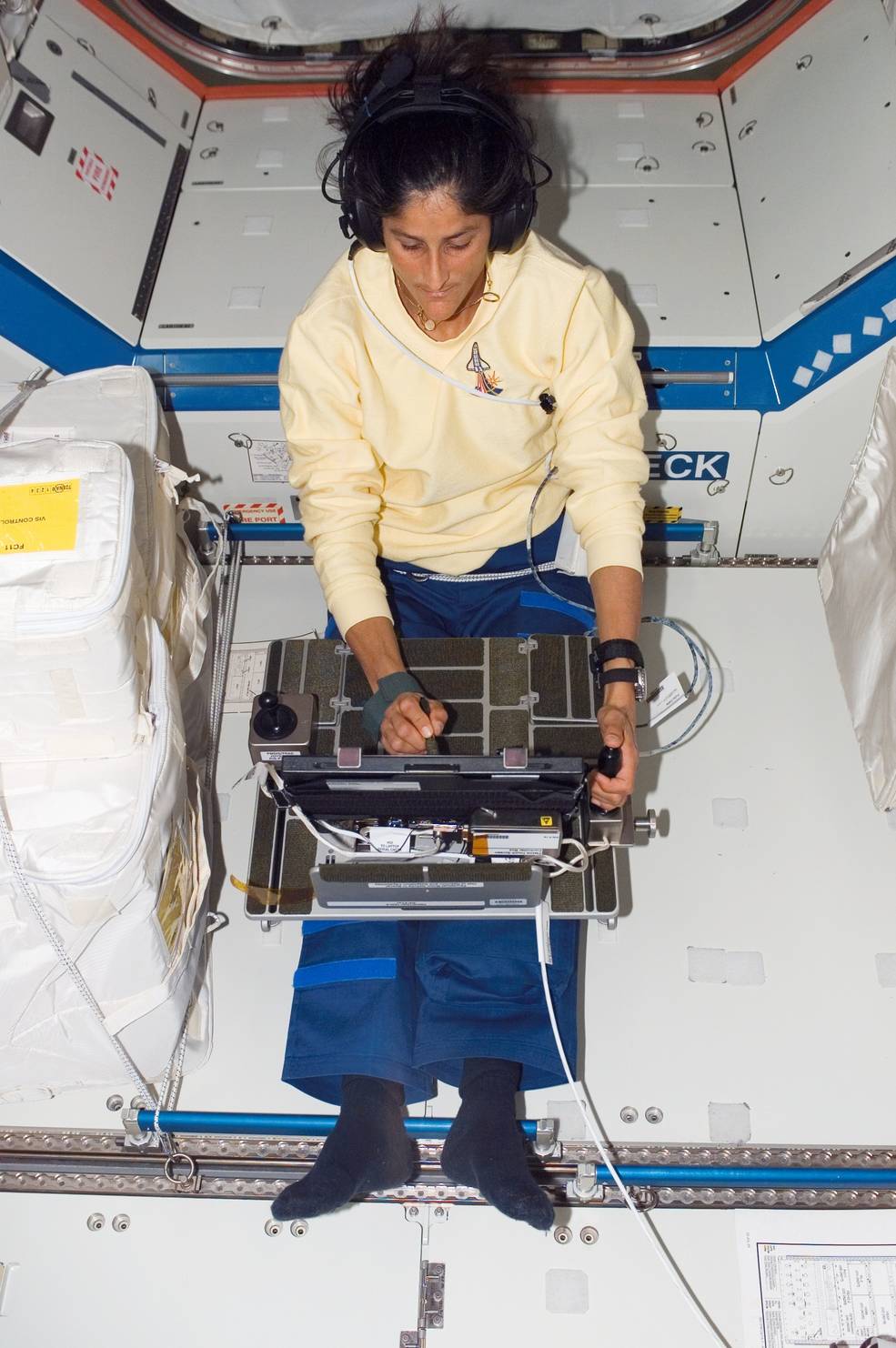
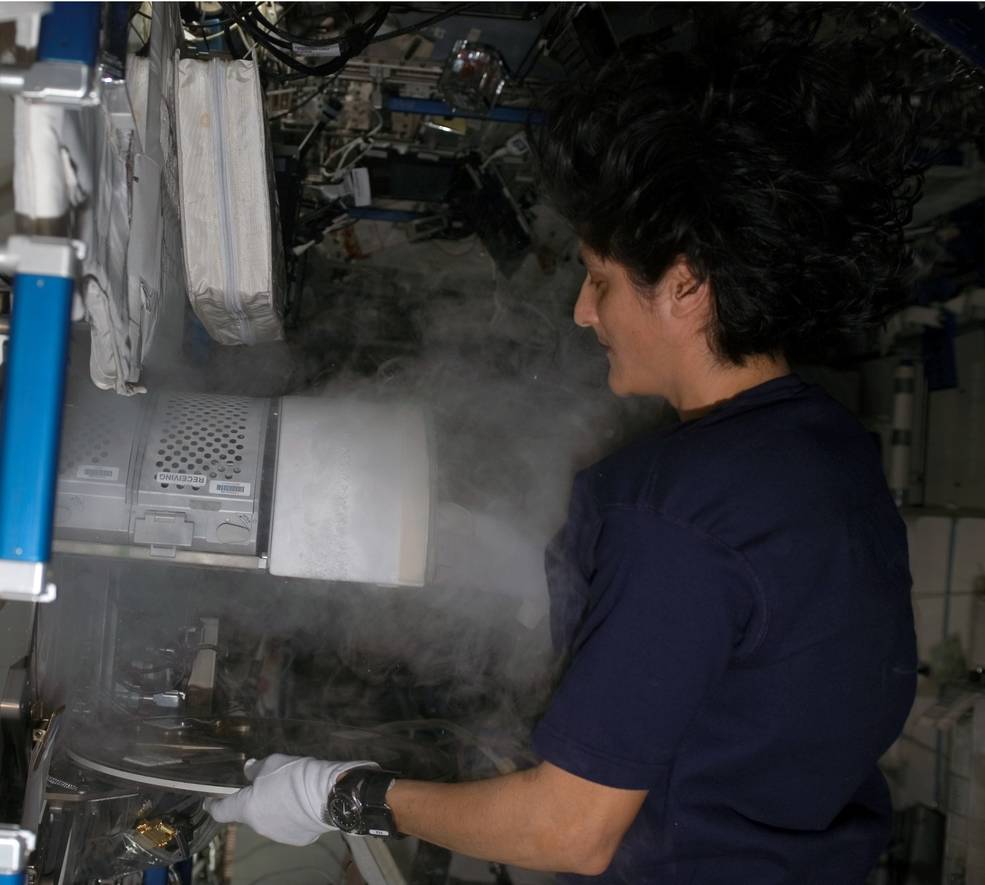
Far left: NASA astronaut Sunita L. Williams, upper left, with her STS-116 crewmates and the Expedition14 crew she was about to join. Middle left: Williams during the third STS-116 spacewalk. Middle right: Williams conducting a session of a Canadian coordination experiment in the Destiny module. Far right: Williams placing blood samples in the space station freezer..
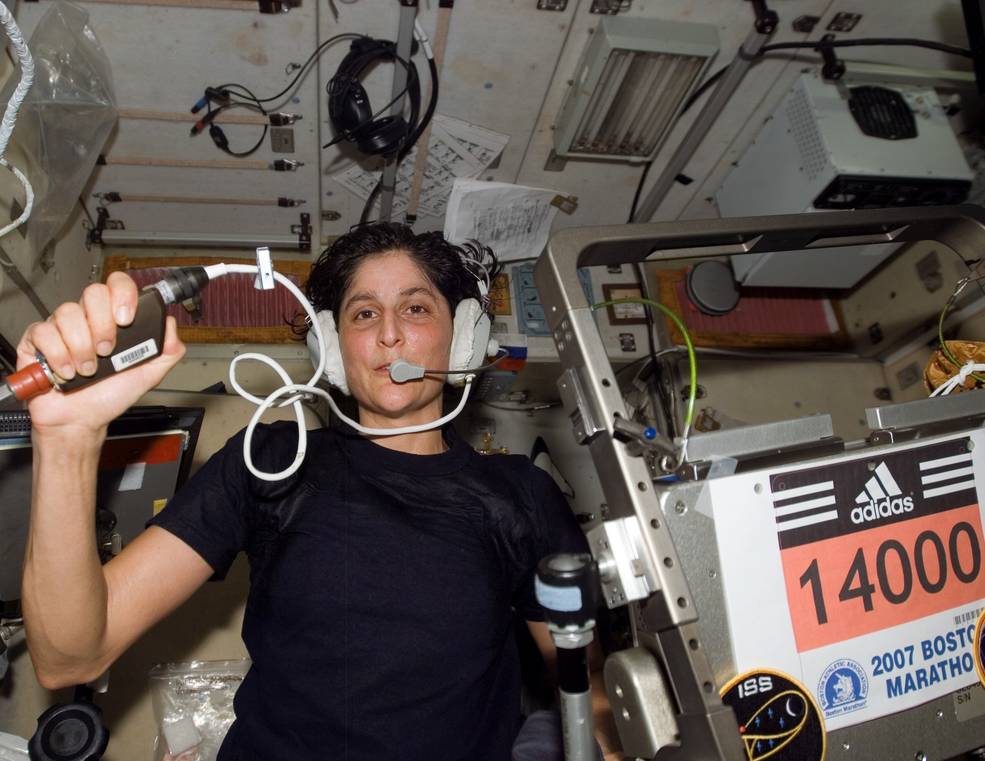
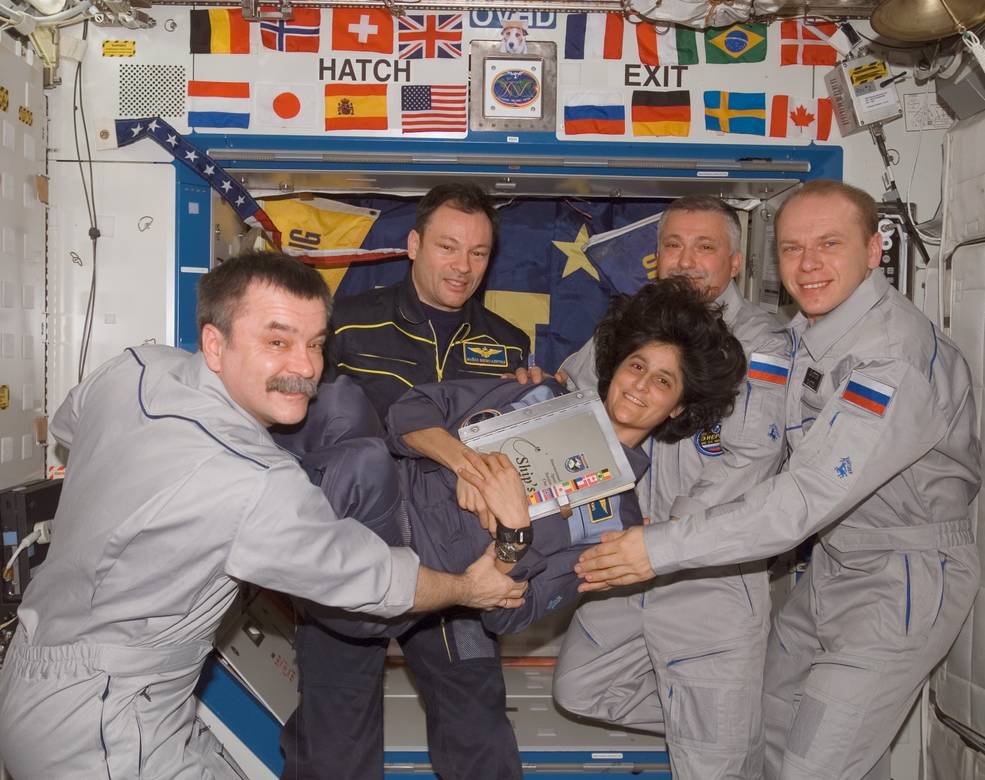
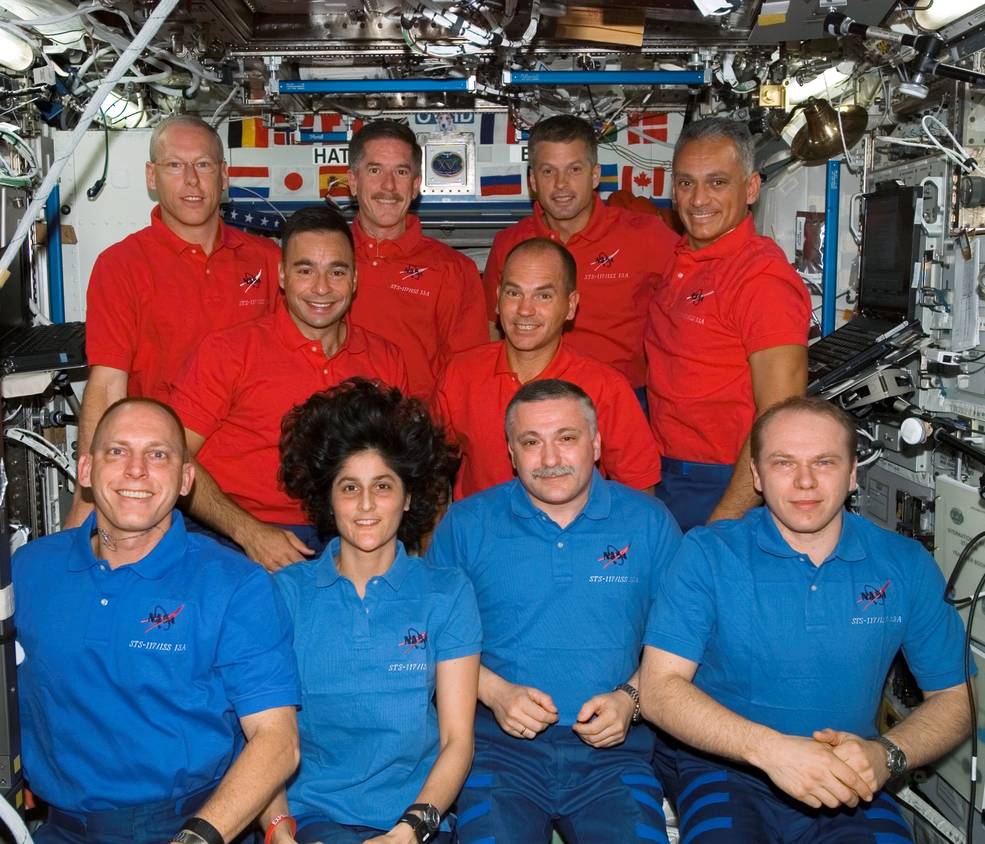
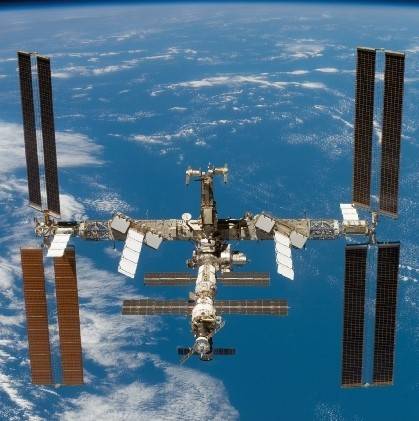
Far left: NASA astronaut Sunita L. Williams participates in the Boston Marathon. Middle left: Williams during the handover between Expedition 14 and 15. Middle right: Williams with her Expedition 15 crewmates and the STS-117 crew that she was about to join. Far right: The space station from the departing STS-117 showing the significant reconfiguration that occurred during her stay.For an encore, Williams returned to the orbital laboratory in July 2012 when she launched aboard Soyuz TMA-05M with Russian cosmonaut Malenchenko and JAXA astronaut Akihiko Hoshide. They joined Russian cosmonauts Gennadi I. Padalka and Sergei N. Revin and NASA astronaut Joseph M. Acaba who had been aboard the space station since May as Expedition 32. In September, just prior to his crew’s departure Padalka turned command over to Williams, who became the second female commander of the space station. Five weeks later, Williams, Malenchenko and Hoshide welcomed three new crew members to round out Expedition 33: Russian cosmonauts Oleg V. Novistsky and Yevgeni I. Tarelkin, and NASA astronaut Kevin A. Ford. In addition to a full complement of research activities, Williams and her crewmates oversaw the arrival of four resupply vehicles including two Progress, one HTV (H-II Transfer Vehicle), and the first operational mission of Space Exploration Corporation’s (SpaceX) Dragon commercial cargo spacecraft. Williams and Hoshide performed four spacewalks for a variety of repair and maintenance tasks, extending her record to more than 50 hours across her career seven spacewalks. Williams and her two crewmates returned to Earth after 127 days in space.
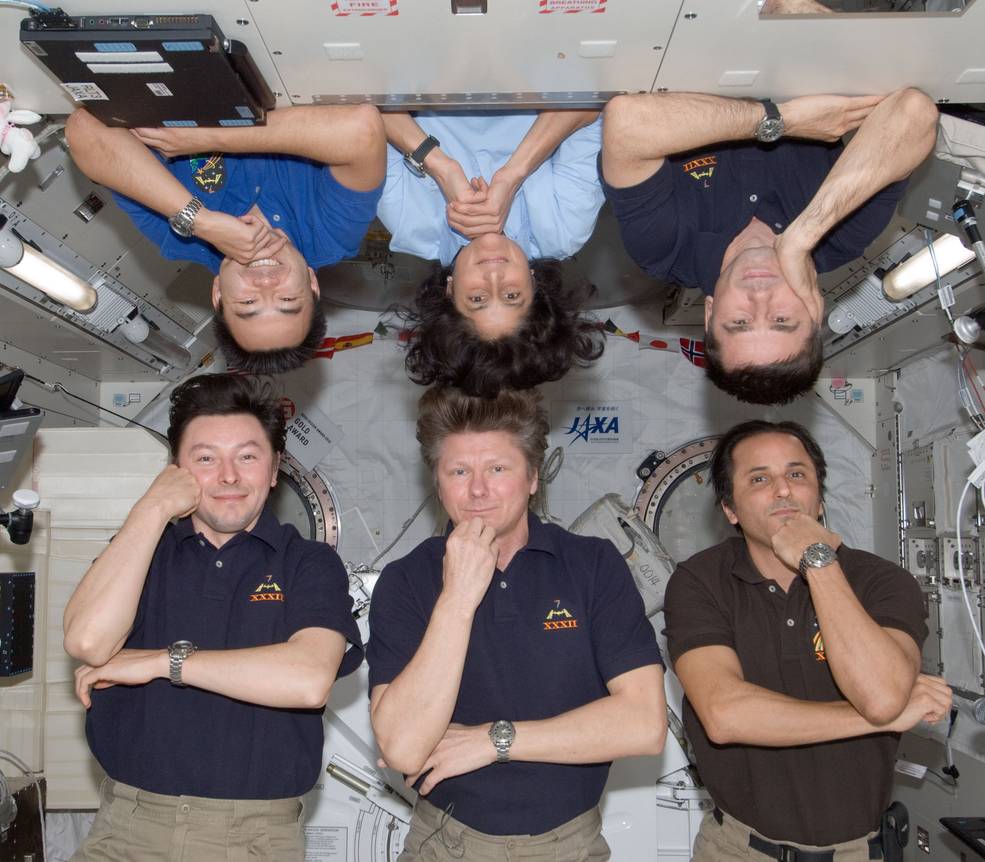
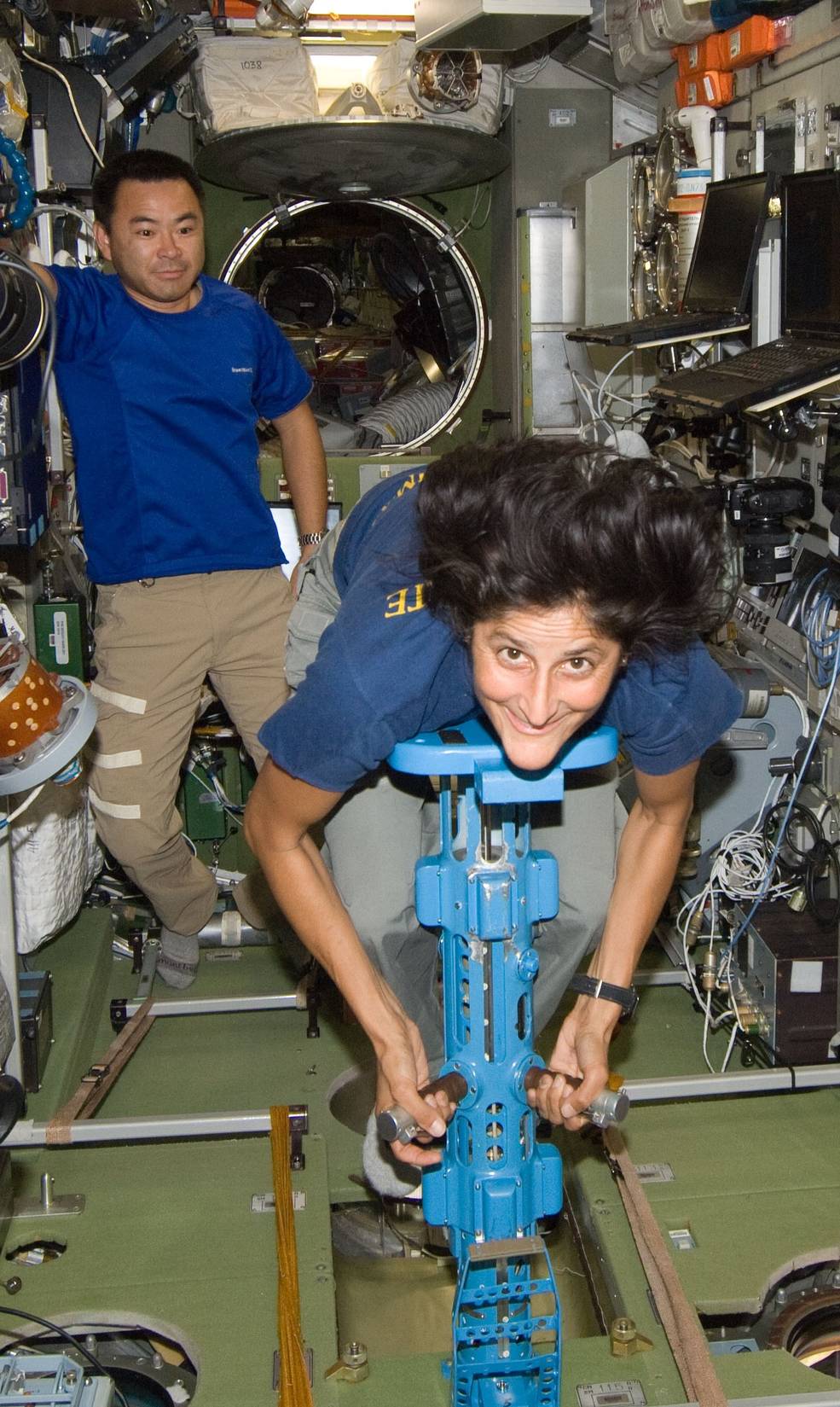
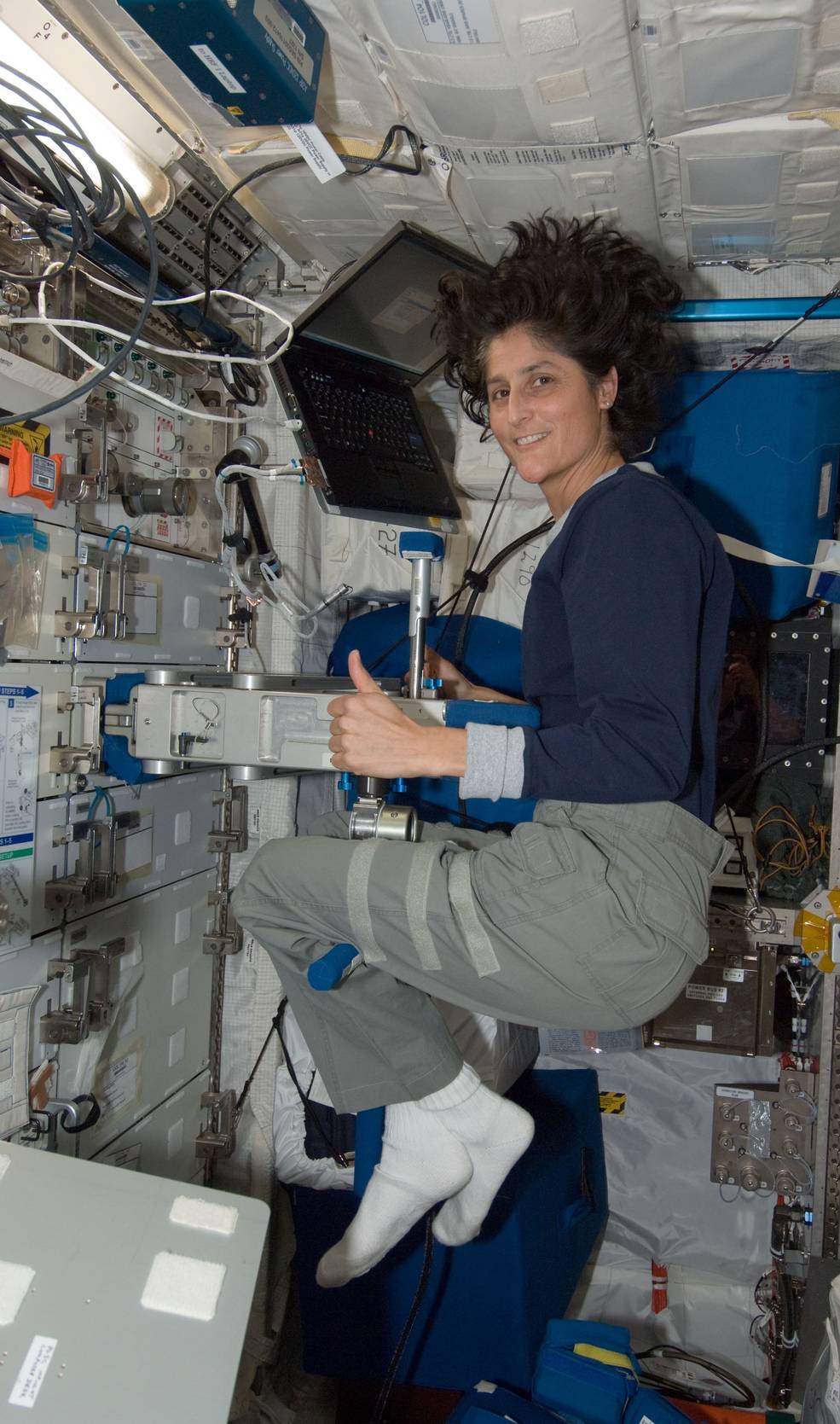
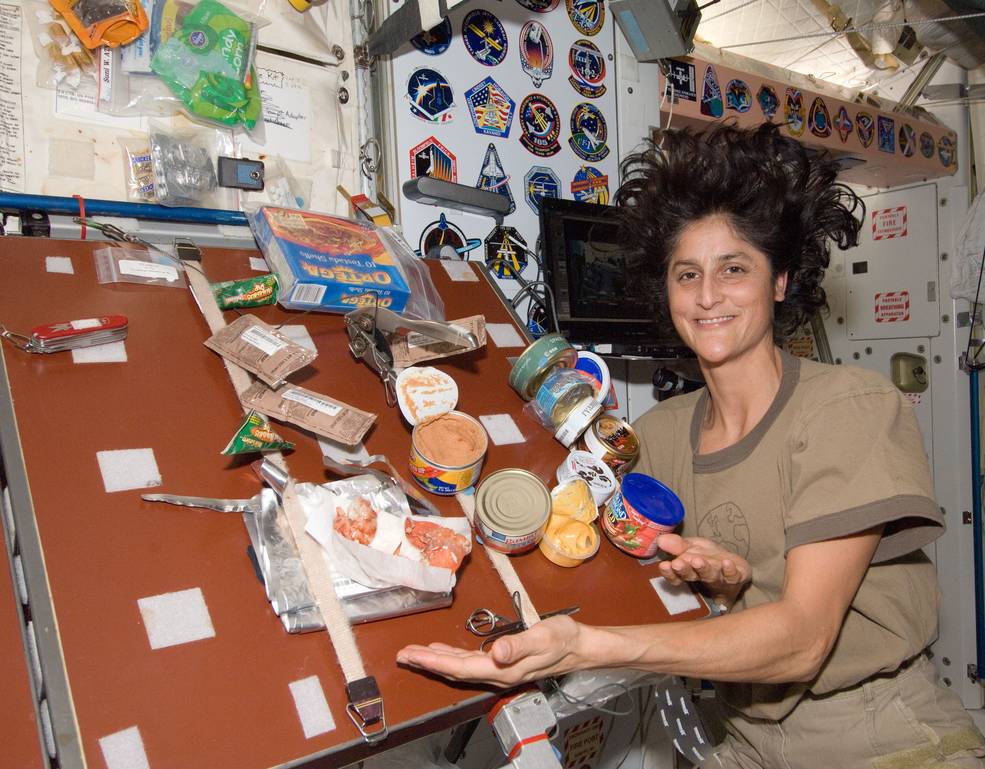
Far left: NASA astronaut Sunita L. Williams, top row, middle, with her pensive Expedition 32 crewmates. Middle left and middle right: Williams demonstrates two ways to weigh yourself in space, using the Russian massmeter and NASA’s mass measurement device. Far right: “Dinner is served,” by “chef” Williams.
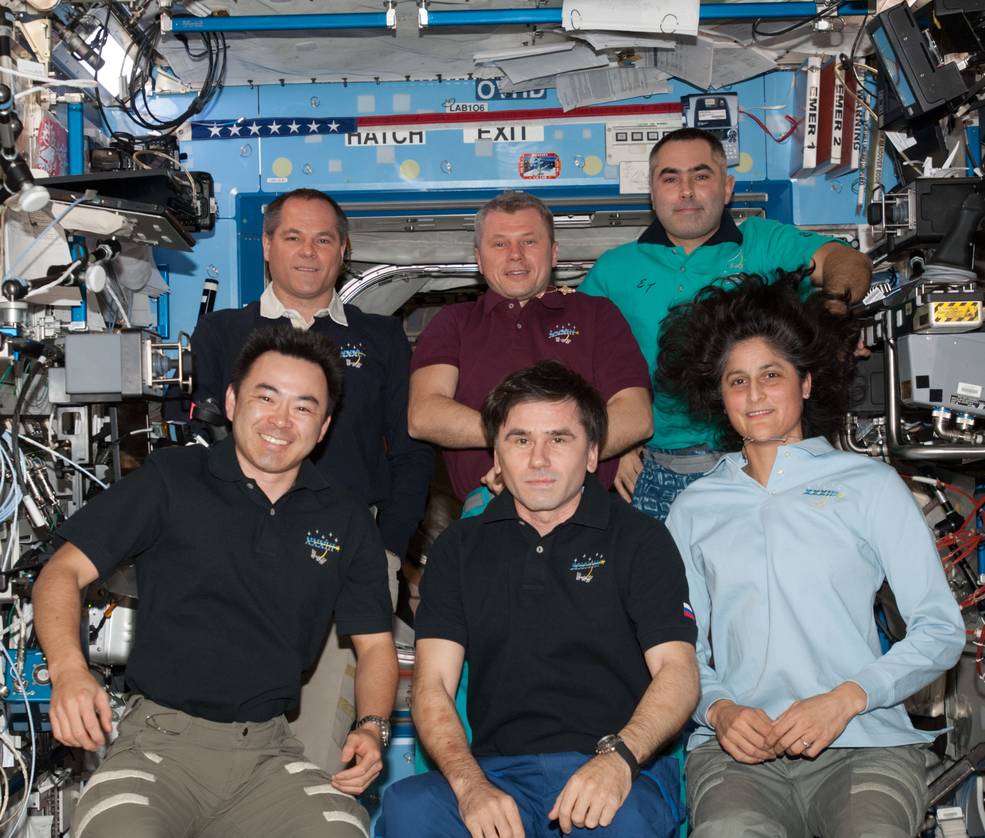
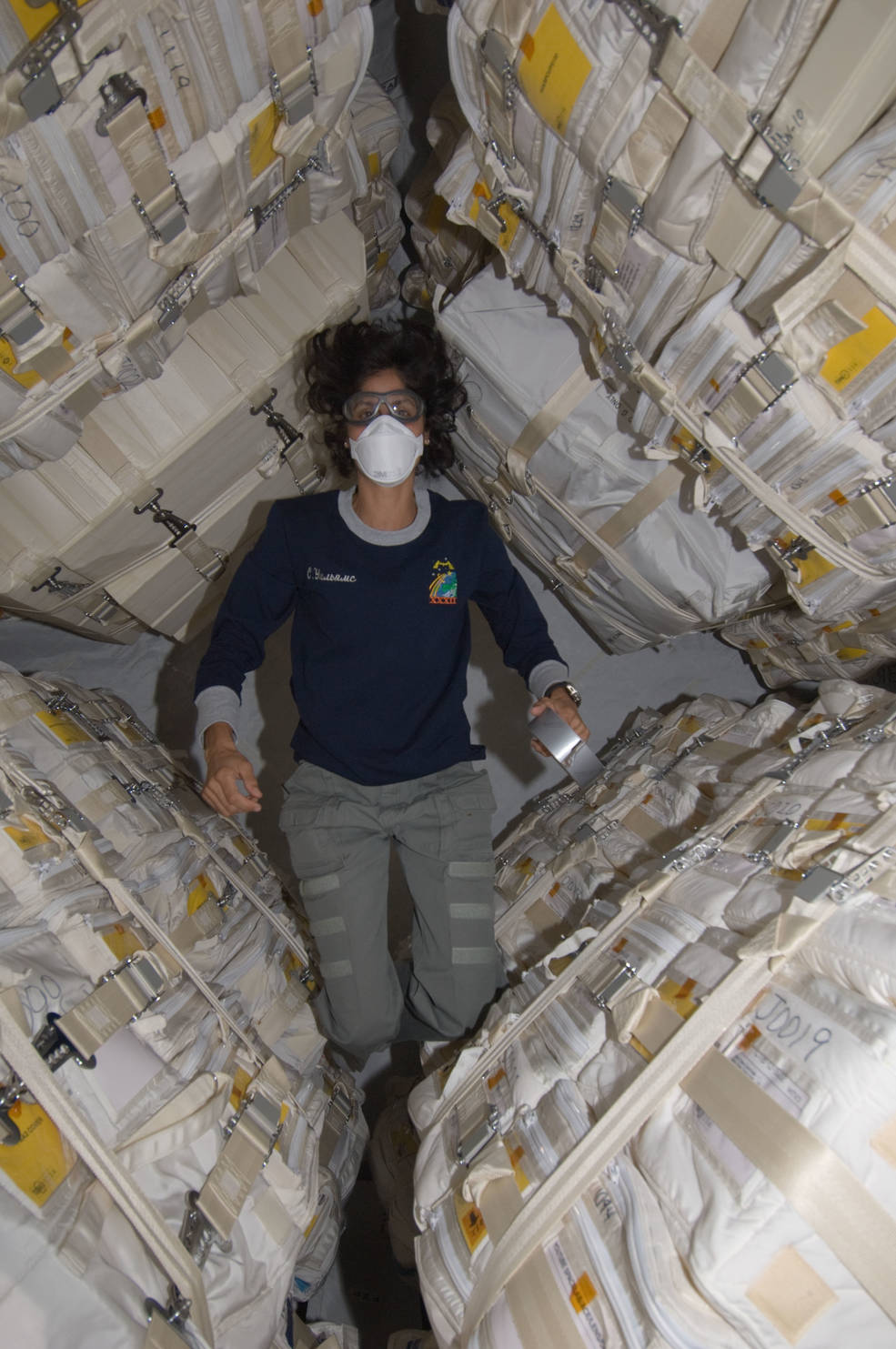
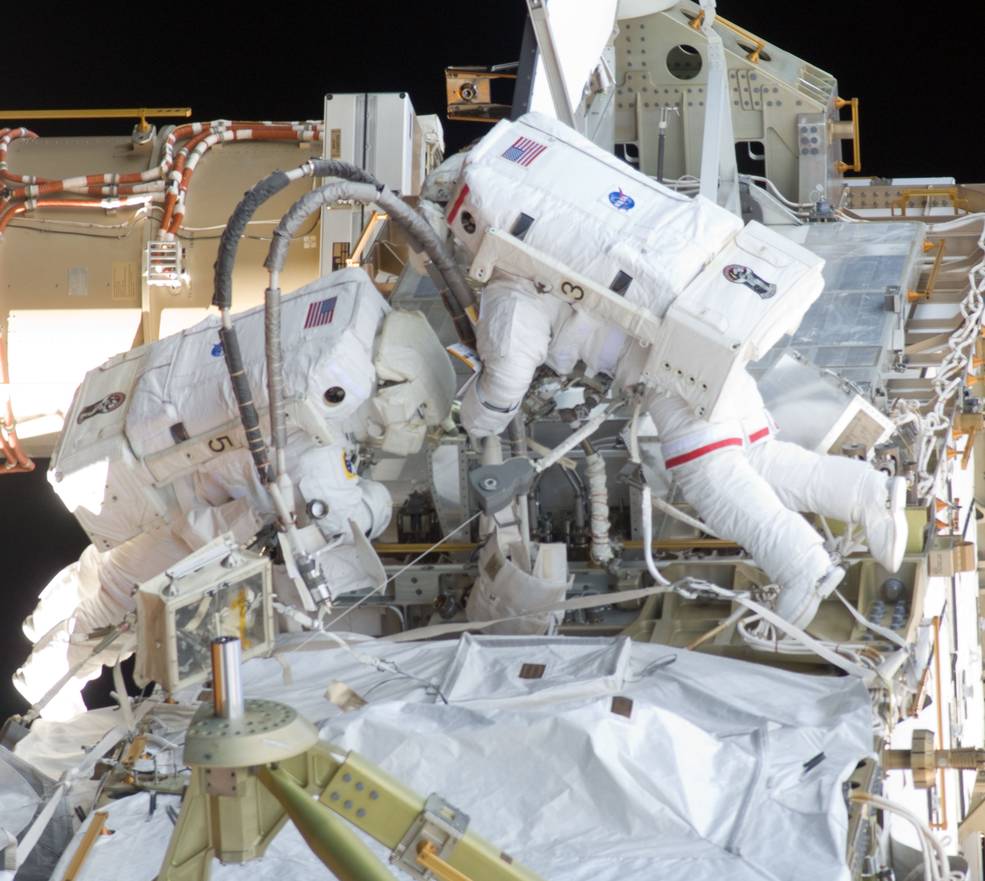
Left: NASA astronaut Sunita L. Williams, front row, right, with her Expedition 33 crewmates. Middle: A masked and goggled Williams in the newly arrived Japanese HTV-3 cargo resupply vehicle. Right: Williams, right, and Hoshide during their third spacewalk.
NASA astronaut Kjell N. Lindgren’s first flight into space began on July 22, 2005, with a launch aboard Soyuz TMA-17M with Russian veteran cosmonaut Oleg D. Kononenko and first-time flyer JAXA astronaut Kimiya Yui. They joined the Expedition 44 crew of Russian cosmonauts Padalka and Mikhail B. Korniyenko and NASA astronaut Scott J. Kelly, the latter two four months into their planned year-long mission aboard the orbiting laboratory. Lindgren began a busy research program that, among other experiments, included the growing of lettuce in the Veggie apparatus. As a bonus, the scientists allowed the crewmembers to taste the lettuce, first plain and then with oil and vinegar, prior to freezing the remaining plants for analysis back on Earth. A new crew arrived in September, including Russian cosmonaut Sergey A. Volkov as a new resident crewmember, ESA astronaut Andreas E. Mogensen, and Kazakh cosmonaut Aidyn A. Aimbetov. The trio made a short visit to the space station – the unusual direct handover necessitated by the one-year mission. Lindgren and Kelly performed two spacewalks, spending 15 hours outside performing upgrades and maintenance on the station. Lindgren, Kononenko and Yui returned to Earth in December after spending 142 days in space.
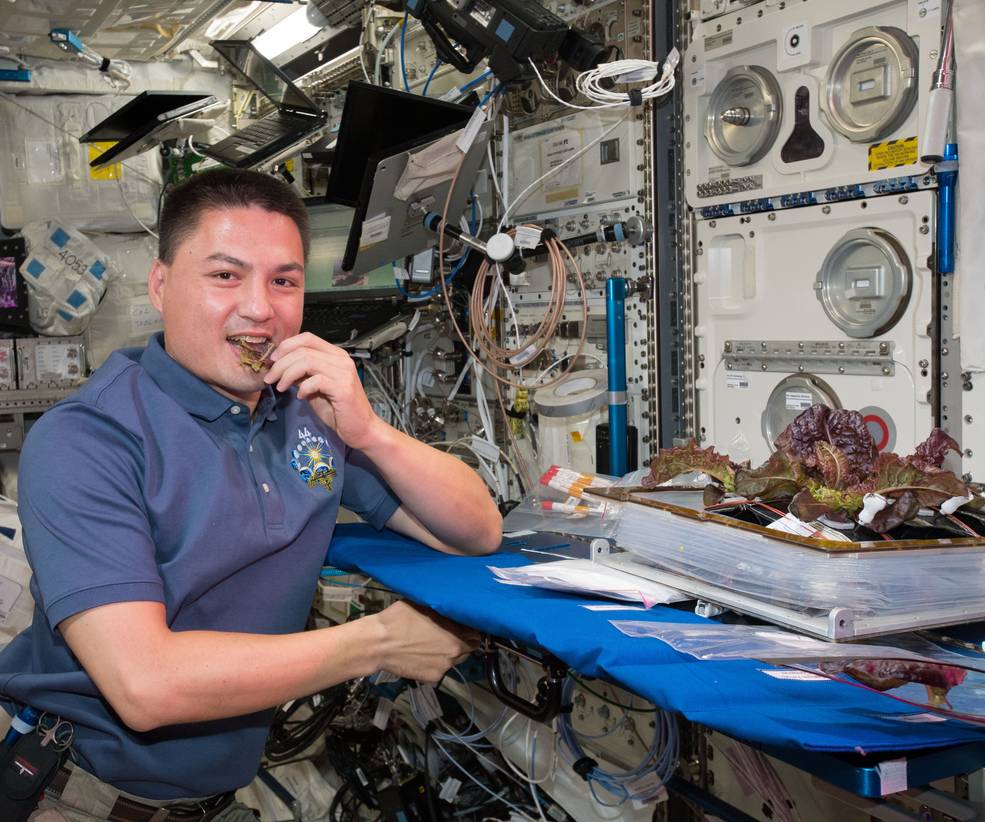
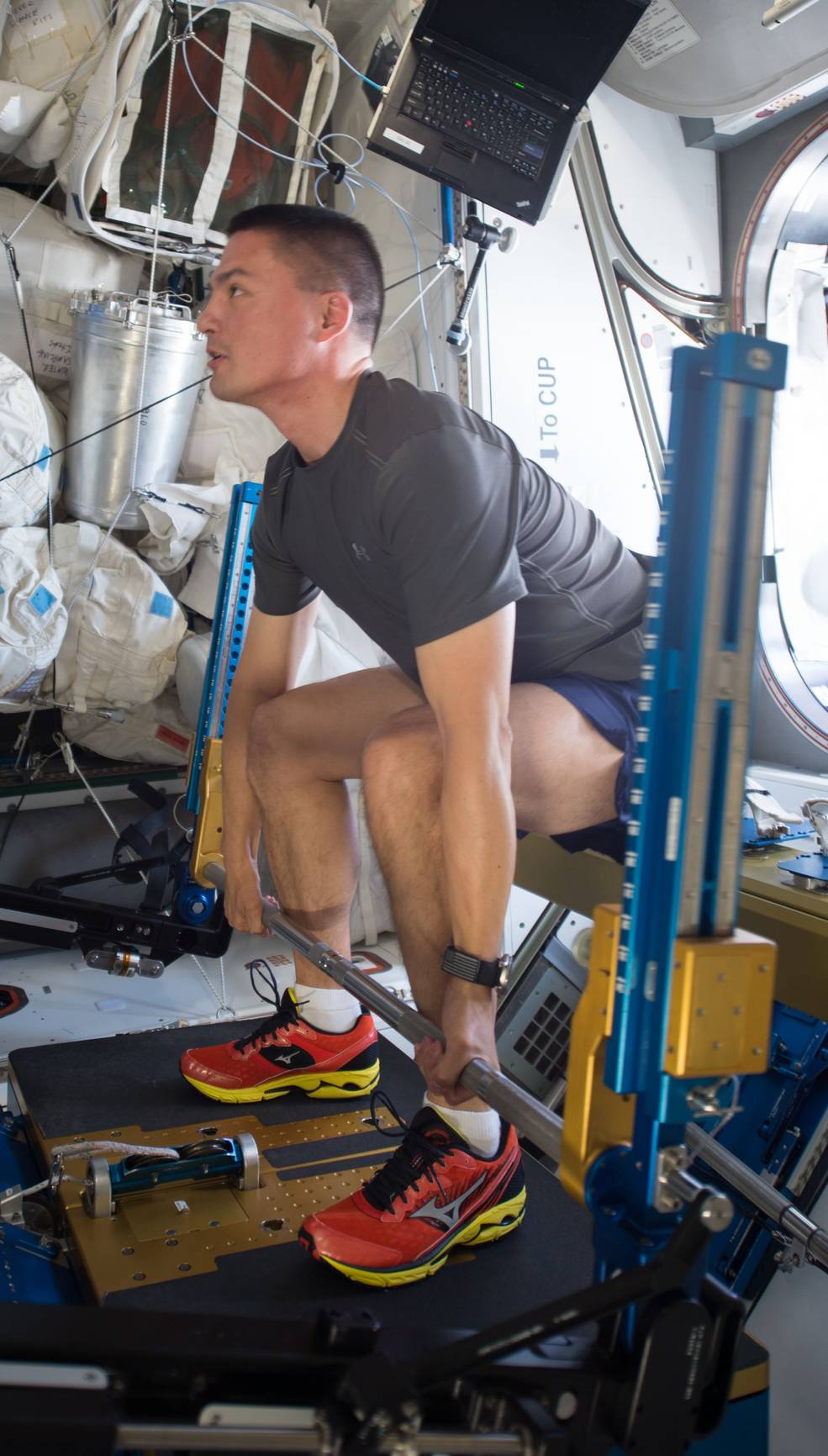
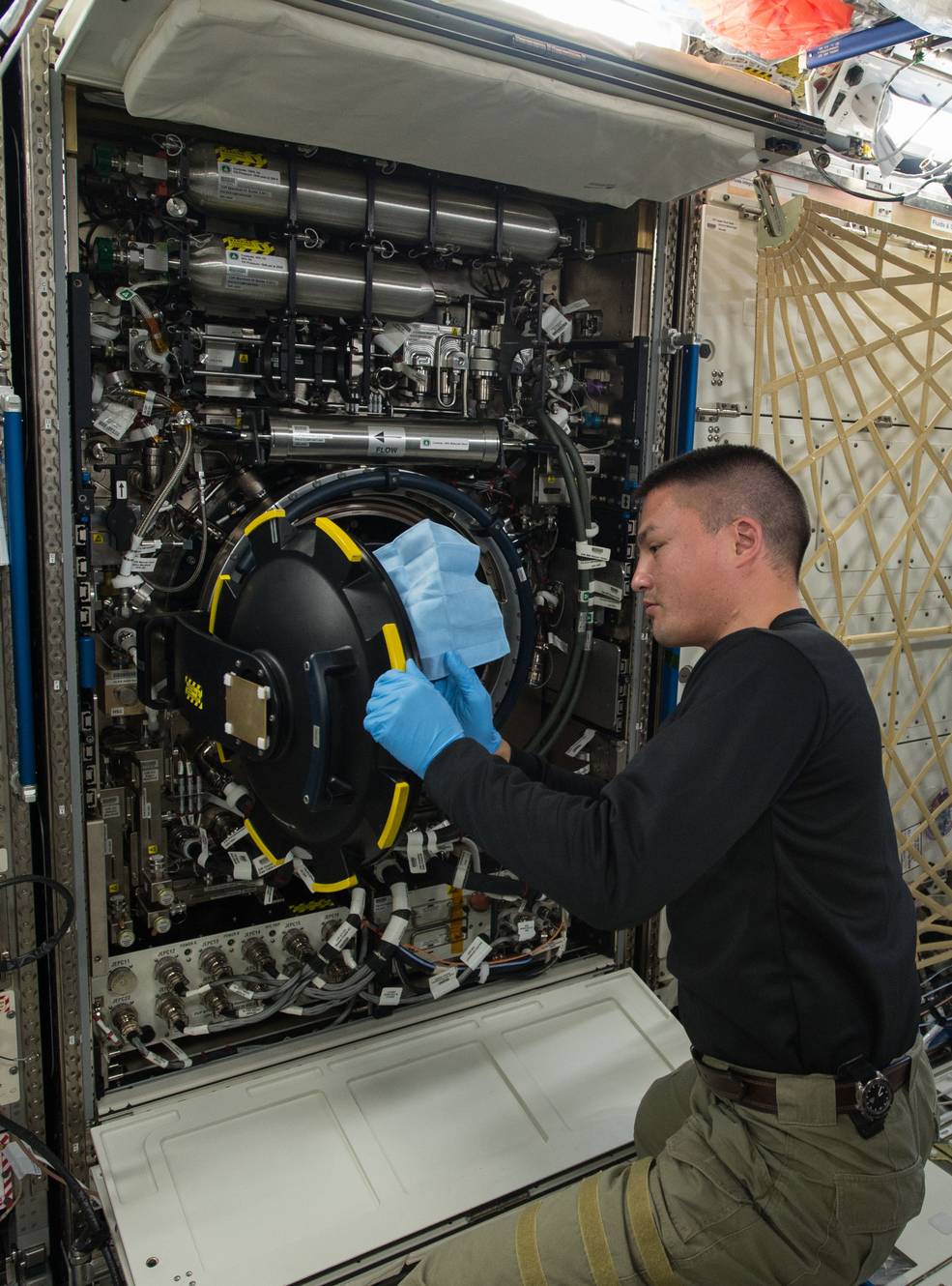
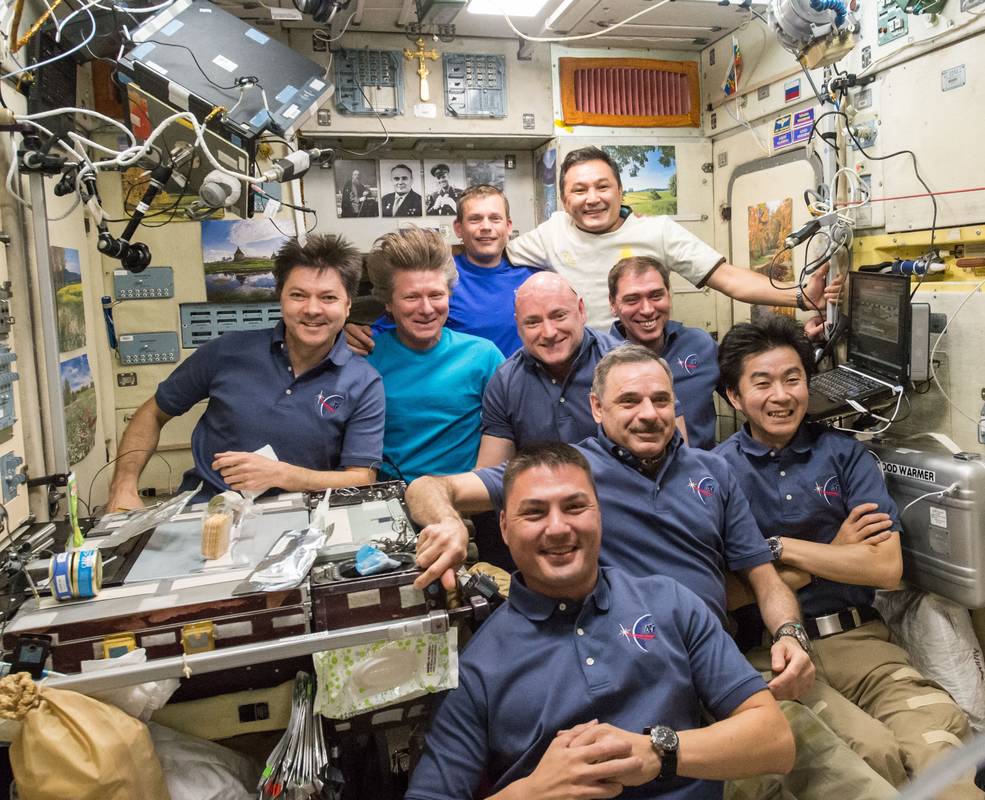
Far left: NASA astronaut Kjell N. Lindgren taste testing the lettuce grown in the Veggie device. Middle left: Lindgren exercising using the Advanced Resistive Exercise Device equipment. Middle right: Lindgren working with the Combustion Integrated Rack. Far right: Lindgren, front and center, with his Expedition 44 and 45 crewmates.
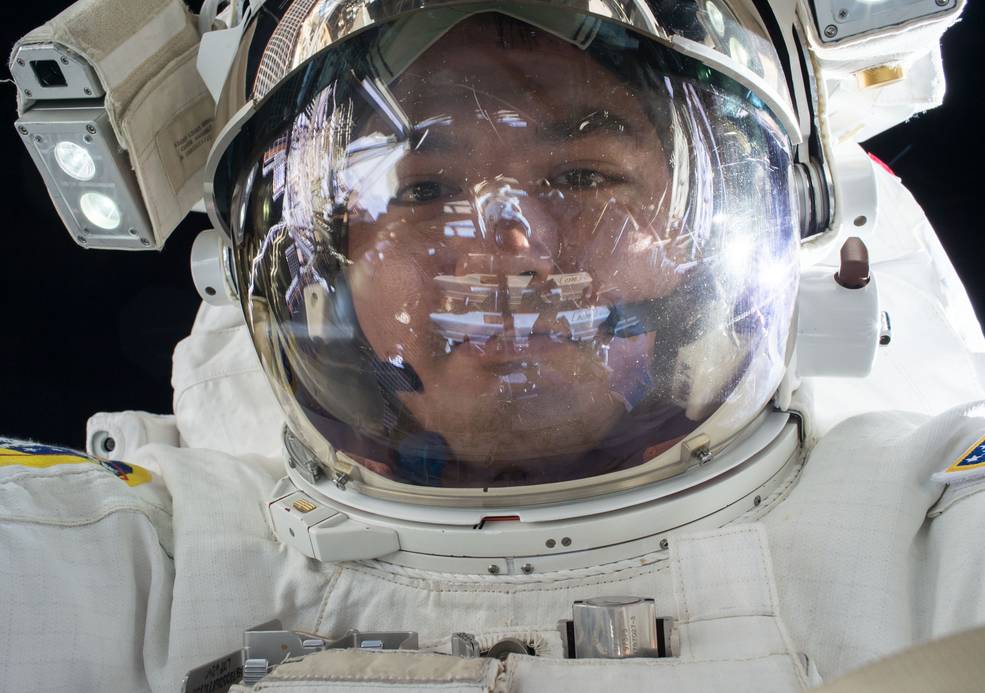
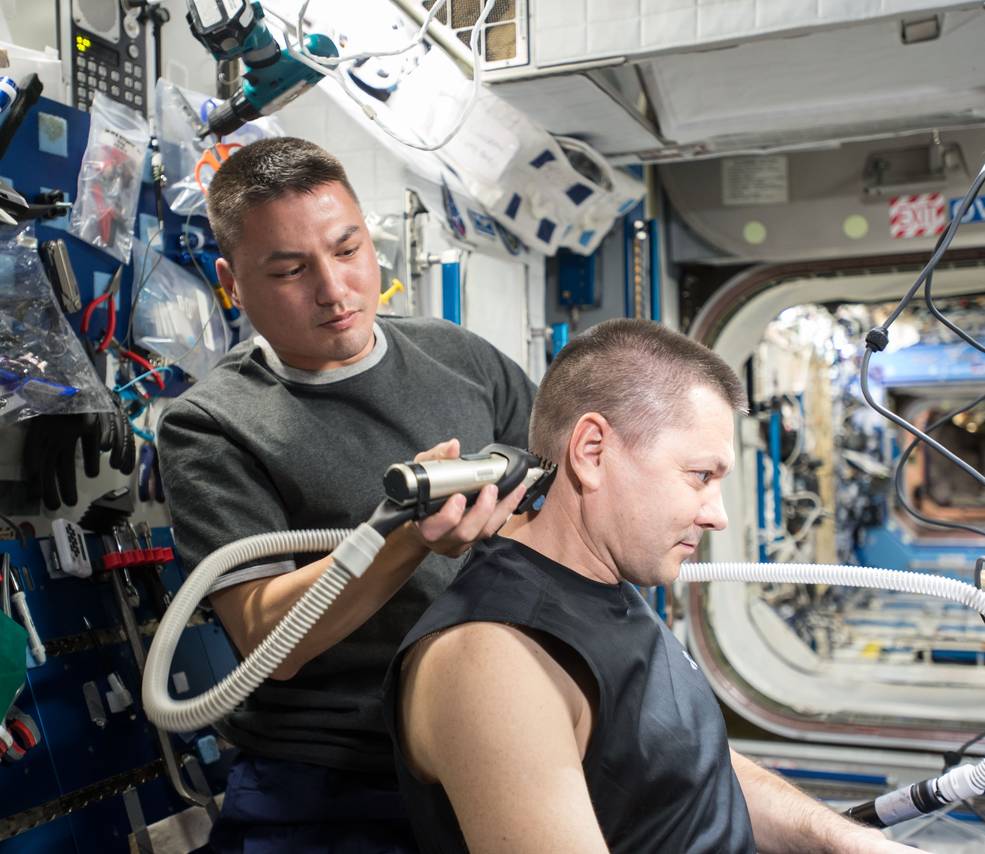
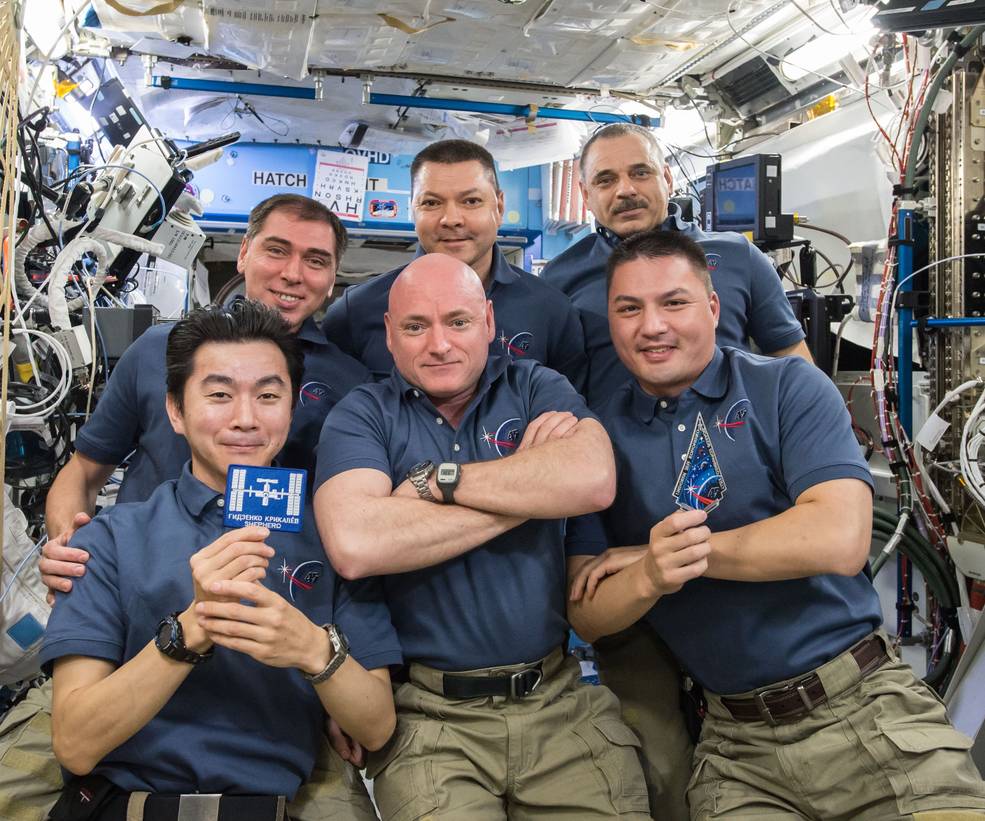
Left: NASA astronaut Kjell N. Lindgren taking a selfie during his second spacewalk. Middle: “And for this I went to medical chool and trained to be an astronaut.” Lindgren gives Russian cosmonaut Oleg D. Kononenko a haircut. Right: Lindgren and his Expedition 45 crewmates commemorate the 15th anniversary of continuous occupancy aboard the International Space Station.
Lindgren returned to space as the commander of NASA’s SpaceX Crew-4 mission aboard the SpaceX Crew Dragon Freedom spacecraft, launched on April 27, 2022. Lindgren and his crewmates NASA astronauts Robert T. Hines and Jessica A. Watkins, and ESA astronaut Samantha Cristoforetti joined the Expedition 67 crew. Lindgren’s mission has just begun.
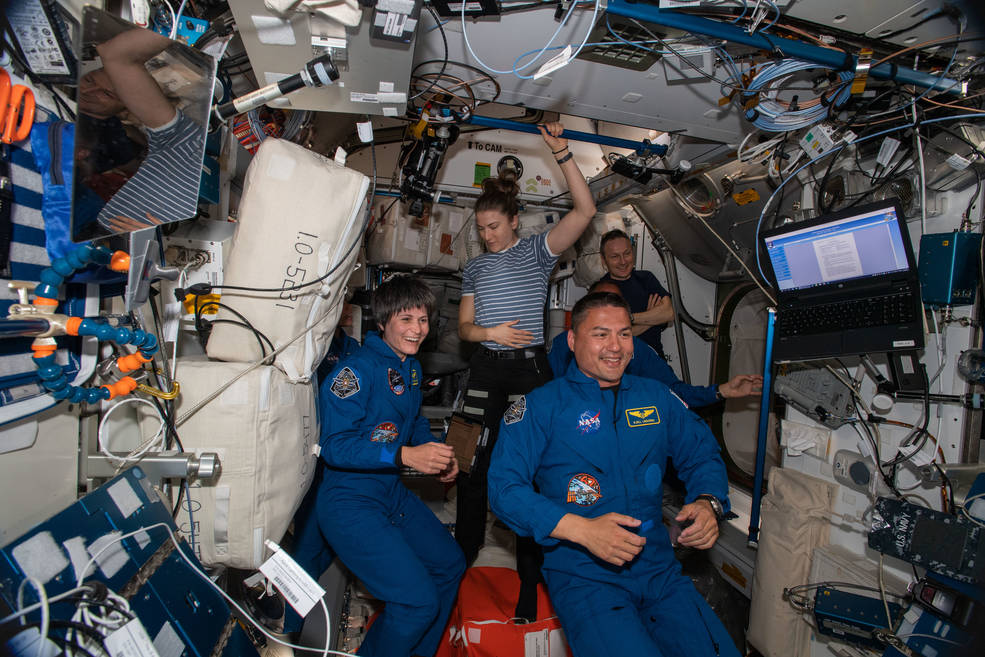
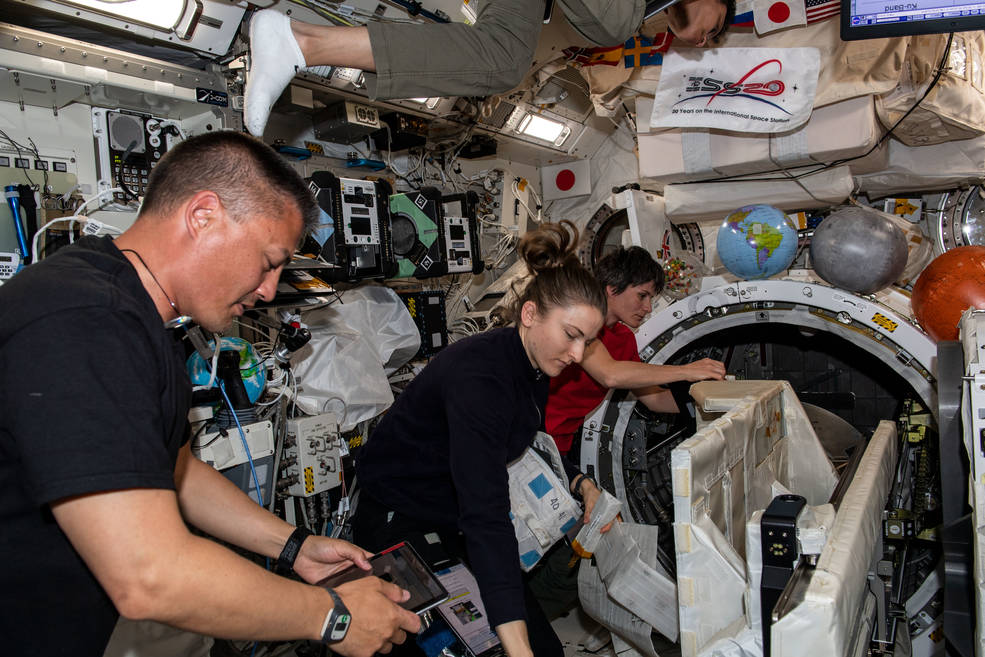
Left: NASA astronaut Kjell N. Lindgren, center, and his fellow Crew-4 astronauts arrive at the space station. Right: Lindgren, left, with fellow Expedition 67 crew members work at the scientific airlock in the Japanese Kibo module.
On November 15, 2020, JAXA astronaut Soichi Noguchi became the first non-NASA crew member to fly on a commercial crew spacecraft when he launched aboard the SpaceX Crew Dragon Resilience on the NASA’s SpaceX Crew-1 mission to the space station. He also became the first person to have experienced a launch on a space shuttle, a Soyuz, and a Crew Dragon. On April 24, 2021, JAXA astronaut Hoshide arrived at the space station aboard Crew Dragon Endeavour as part of the Crew-2 mission, marking the first time that two JAXA long-duration crew members were aboard the orbiting laboratory at the same time.
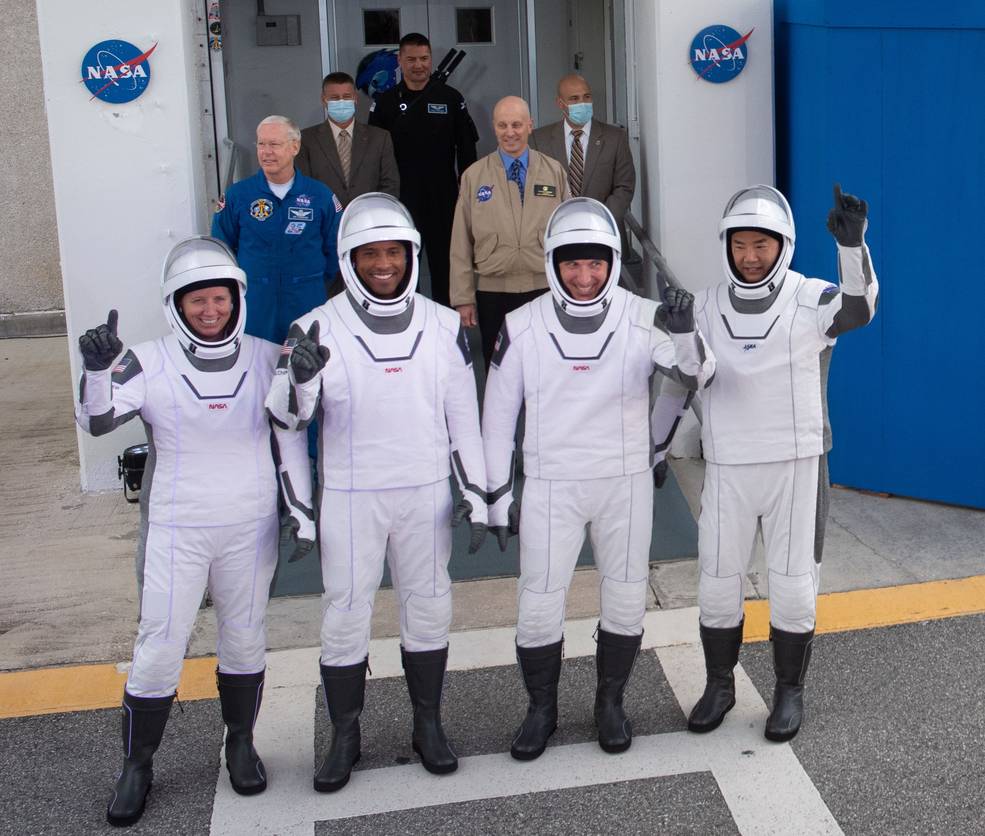
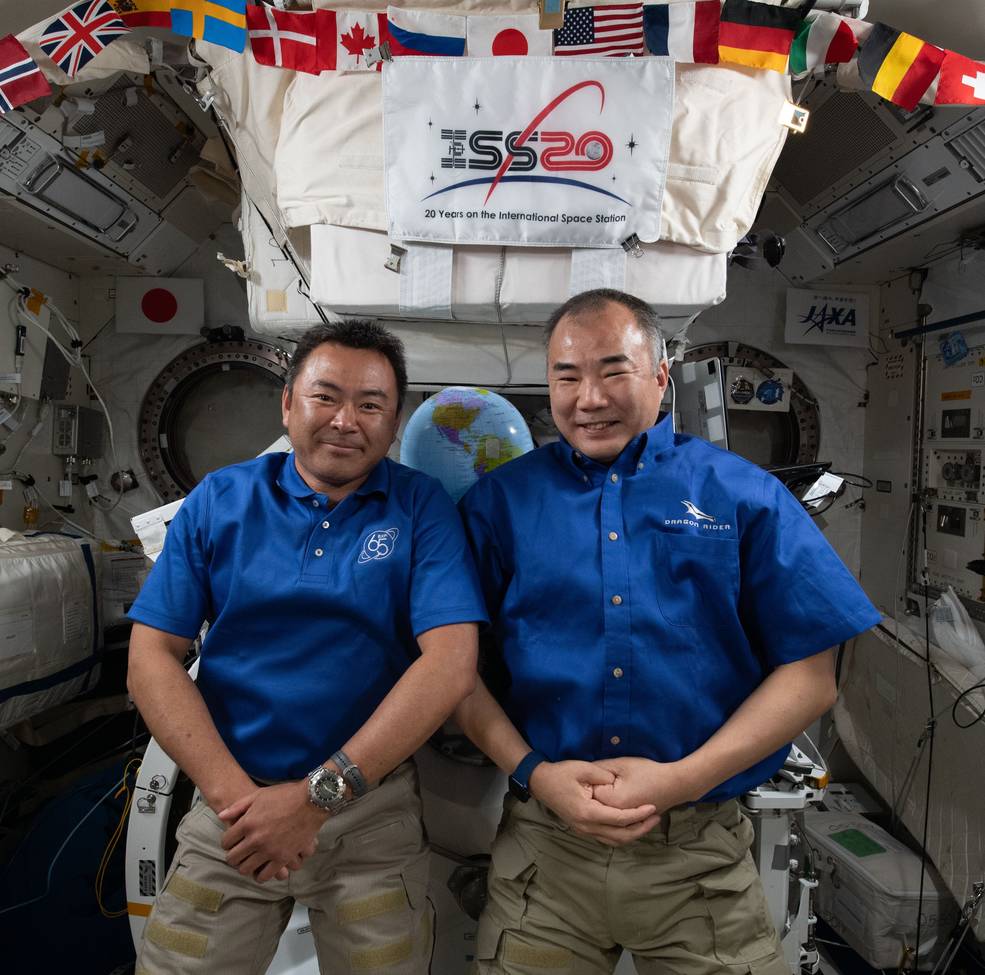
Left: Crew-1 NASA astronauts Shannon Walker, left, Victor J. Glover, Michael S. Hopkins, and Japan Aerospace Exploration Agency (JAXA) astronaut Soichi Noguchi leaving crew quarters on their way to the launch pad. Right: JAXA astronauts Akihiko Hoshide, left, and Noguchi aboard the space station.
Selected by NASA as an astronaut in 2017, Raja J. Chari launched as the Crew-3 commander on SpaceX’s Crew Dragon Endurance on Nov. 10, 2021. Chari and his crewmates NASA astronauts Thomas H. Marshburn, Kayla S. Barron and ESA astronaut Matthias J. Maurer joined the Expedition 66 crew of Anton N. Shkaplerov, and Pyotr V. Dubrov of Roscosmos and NASA astronaut Mark T. Vande Hei. Dubrov and Vande Hei were seven months into their one-year missions when Crew-3 arrived. During Chari’s stay aboard the space station, the Expedition 66 crew played host to a 12-day spaceflight participant mission with Russian cosmonaut Aleksandr A. Misurkin and Japanese citizens Yusaku Maezawa and Yozo Hirano. Russian cosmonauts Oleg G. Artemyev, Denis V. Matveyev, and Sergei V. Korsakov arrived in March 2022 to relieve Shkaplerov, Dubrov, and Vande Hei and to begin Expedition 67. Their next visitors, the 17-day Axiom Mission-1 first private astronaut mission arriving aboard SpaceX’s Crew Dragon Endeavour, included former NASA astronaut and now Axiom Space employee Lopez-Alegria, Larry Connor of the United States, Eytan Stibbe of Israel, and Mark Pathy of Canada. Chari completed two spacewalks, spending nearly 14 hours conducting upgrades and maintenance on the space station. He returned to Earth in May 2022 after a 176-day mission in space.
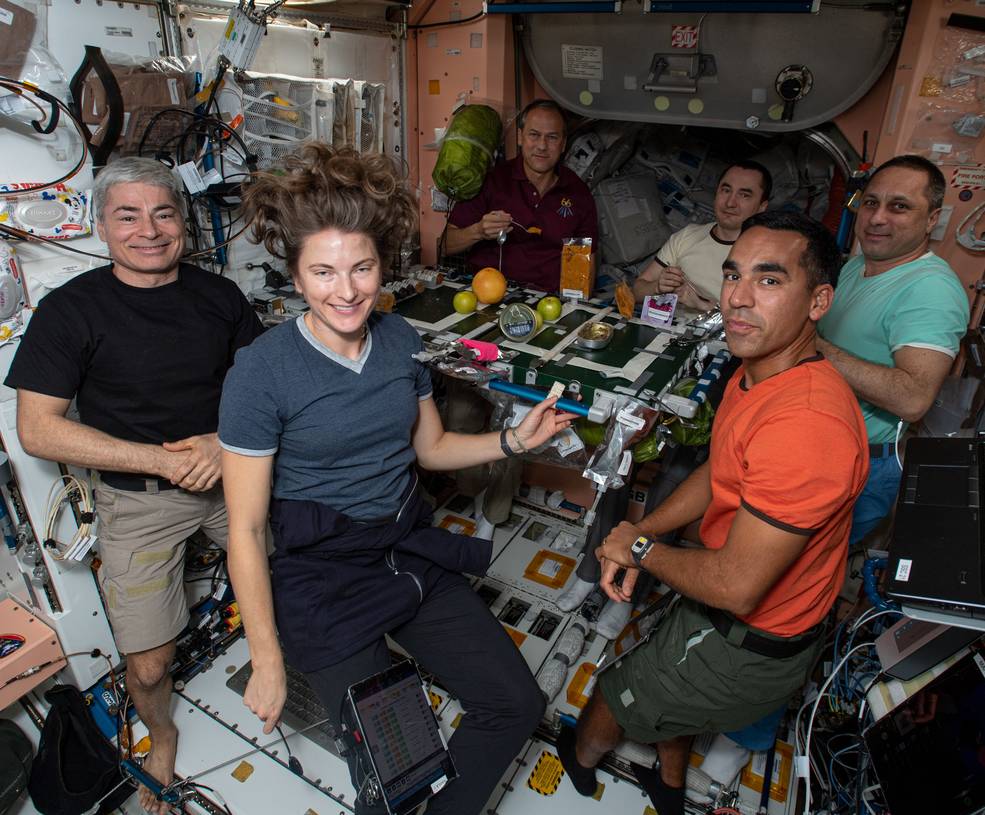
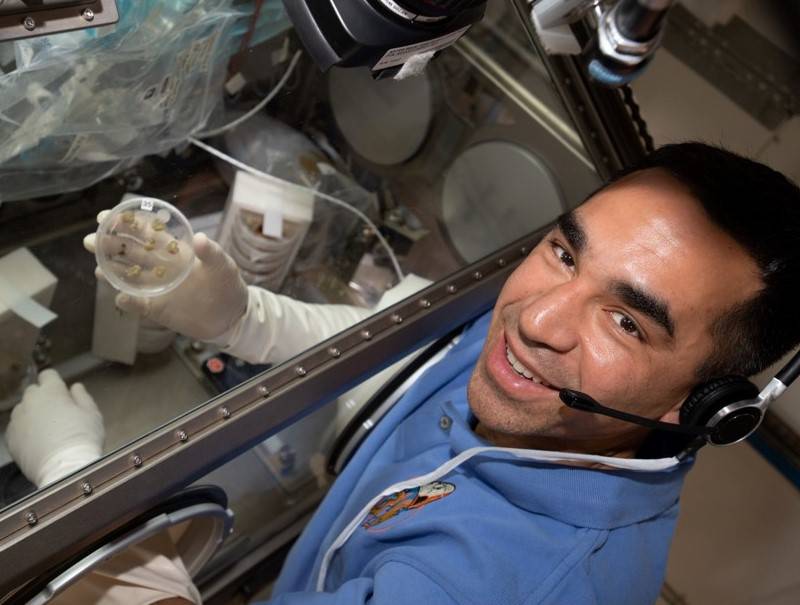
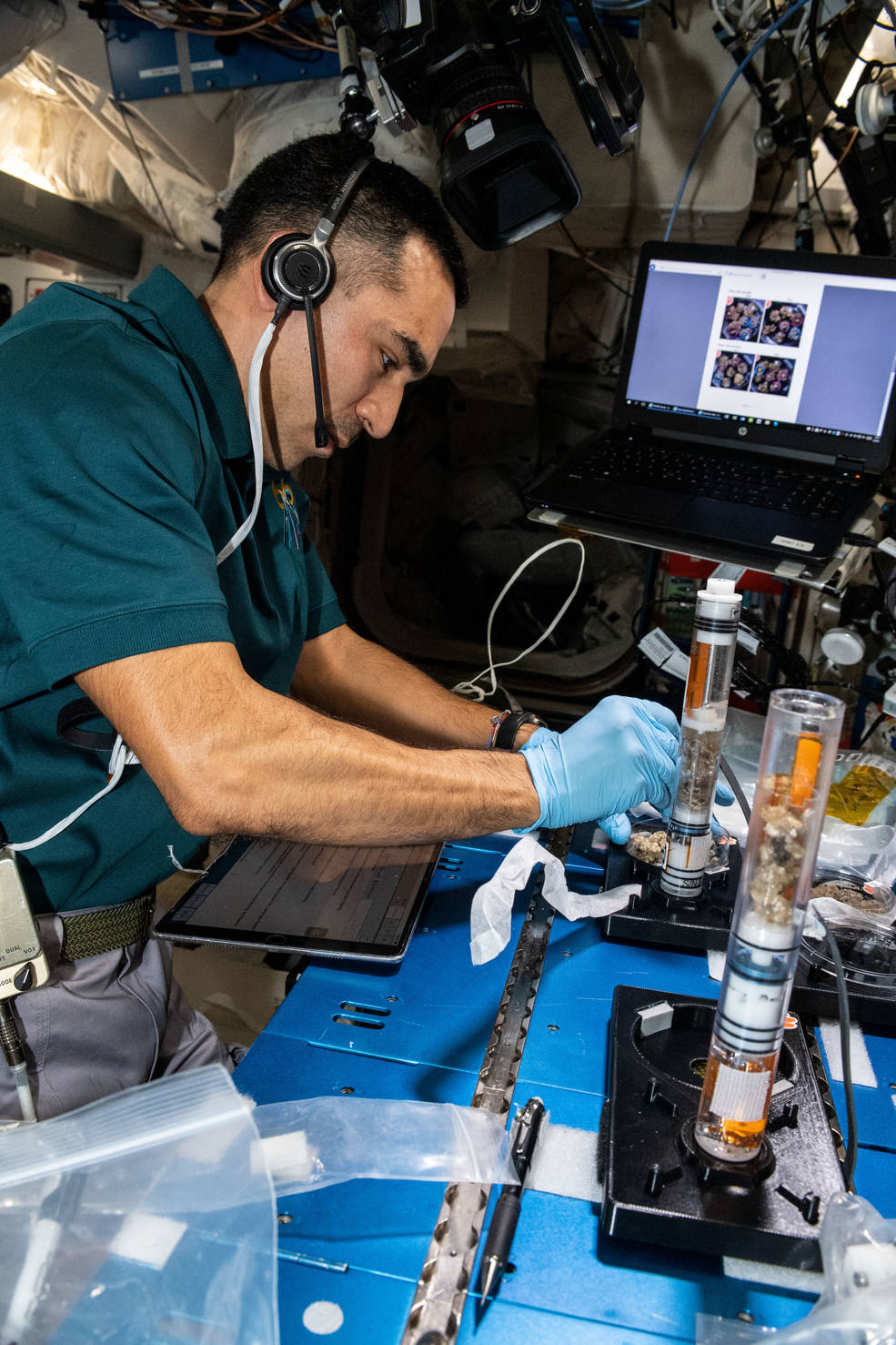
Left: NASA astronaut Raja J. Chari, right front, enjoys Thanksgiving dinner with his Expedition 66 crew mates. Middle: Chari works on an experiment in the Life Sciences Glovebox. Right: Chari performs the final harvest of cotton cell cultures as part of the Plant Habitat-05 investigation.
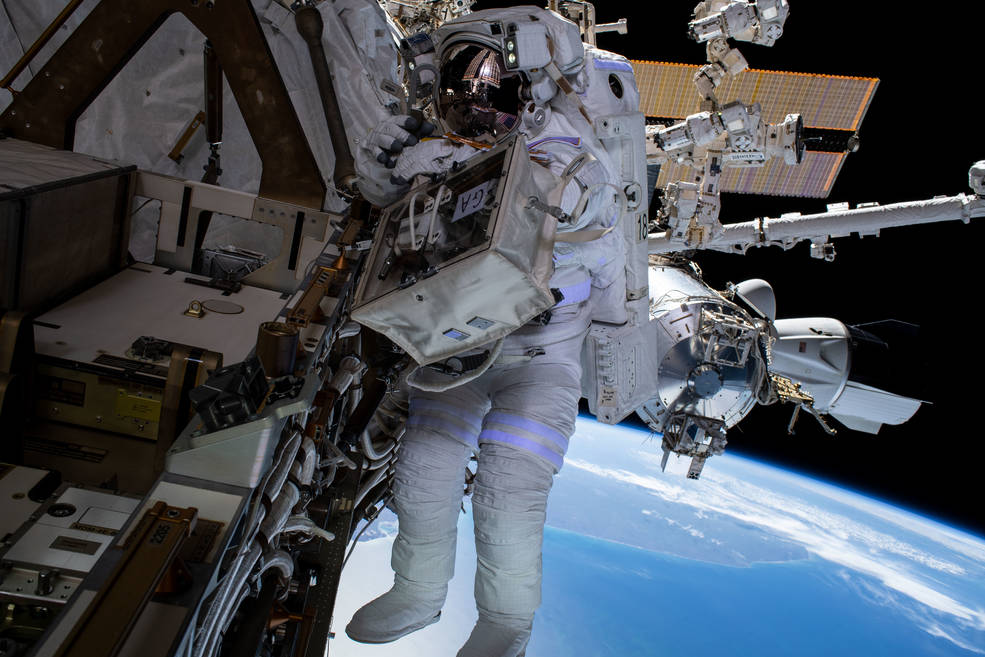
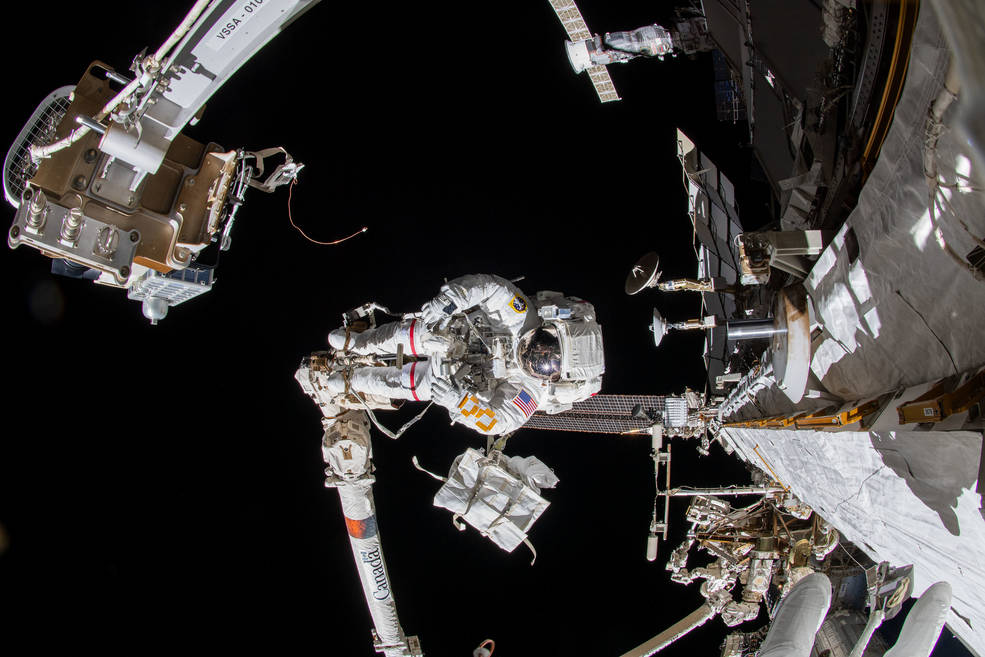
Left: NASA astronaut Raja J. Chari during the spacewalk to prepare for the future installation of a rollout solar array. Right: Chari during the spacewalk to maintain the space station’s heat rejection system.
An earlier version of this article appeared in May 2021.
To be continued…
























